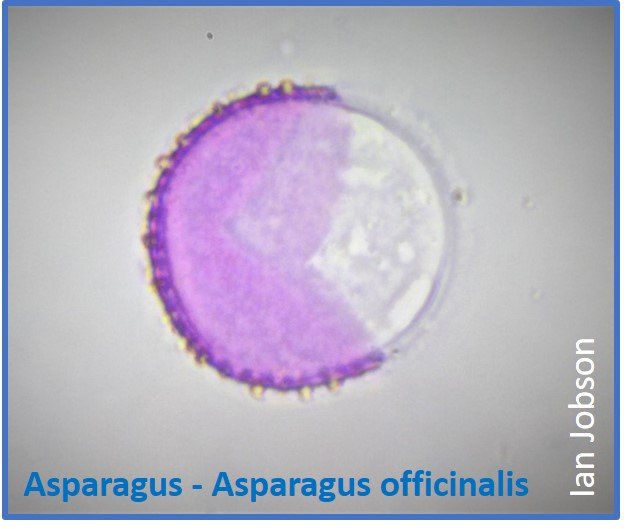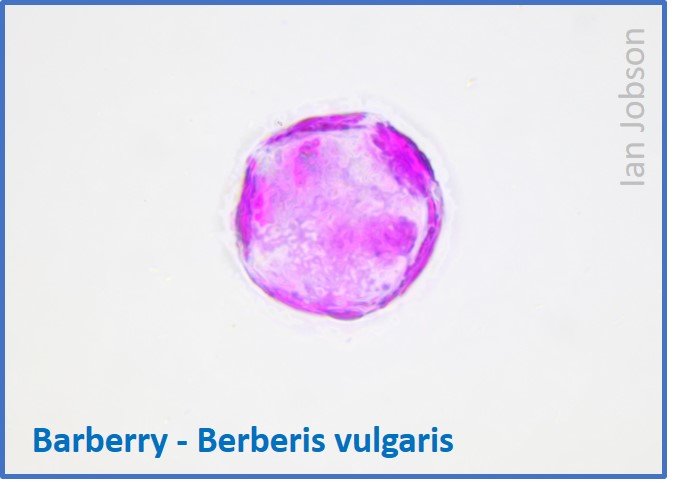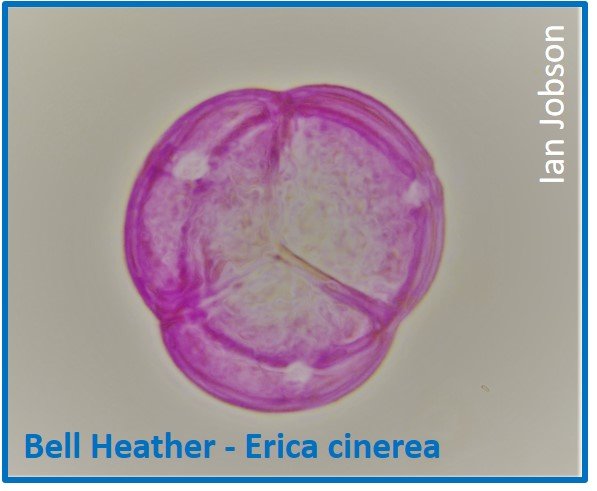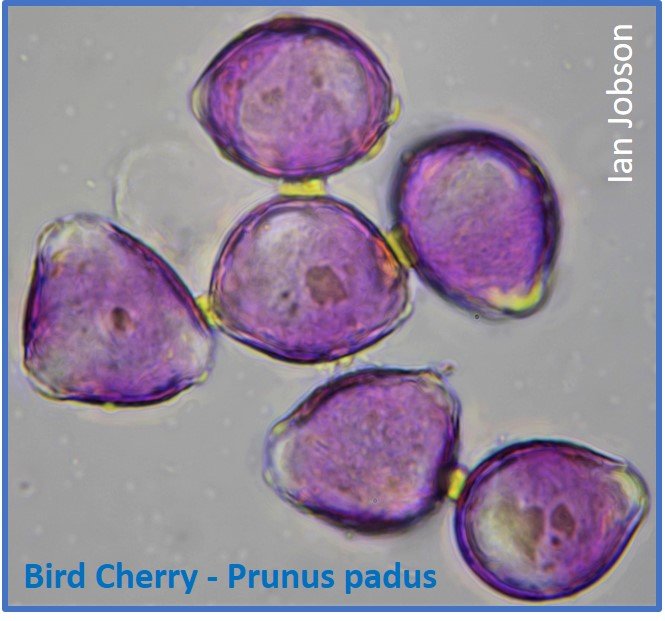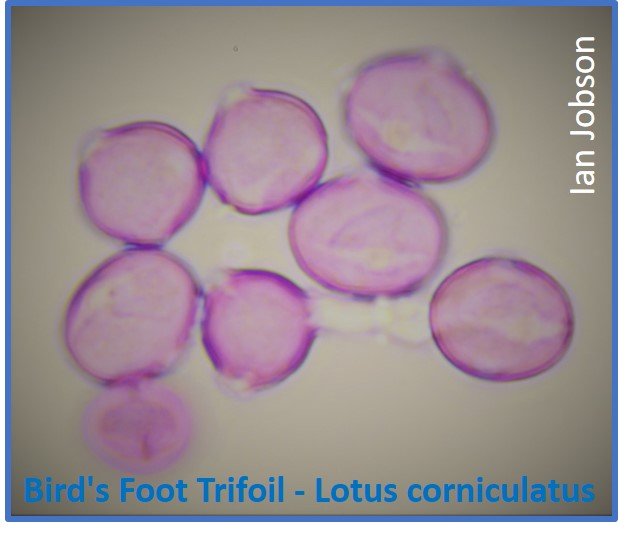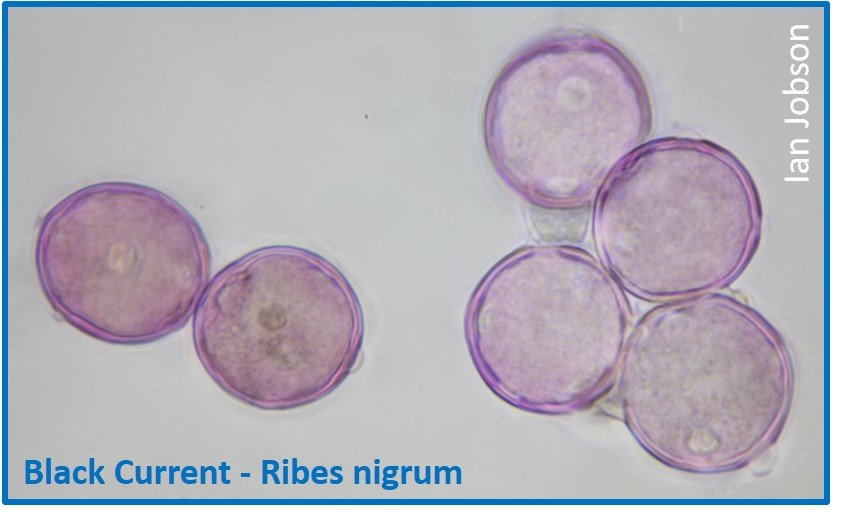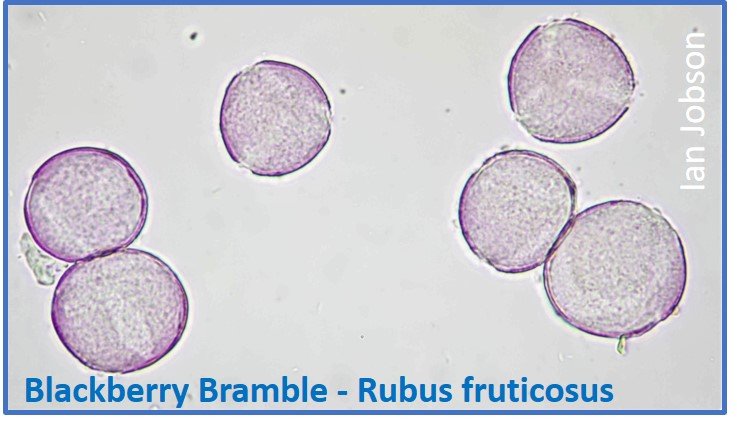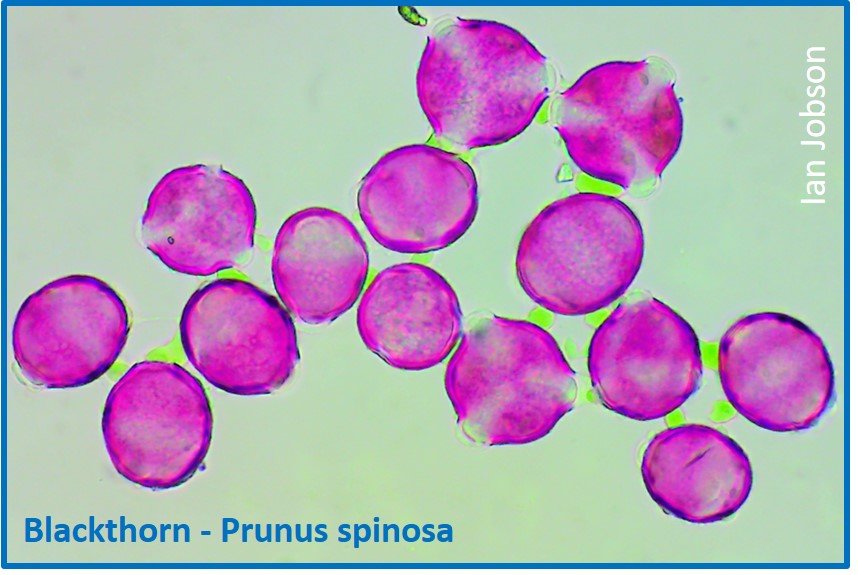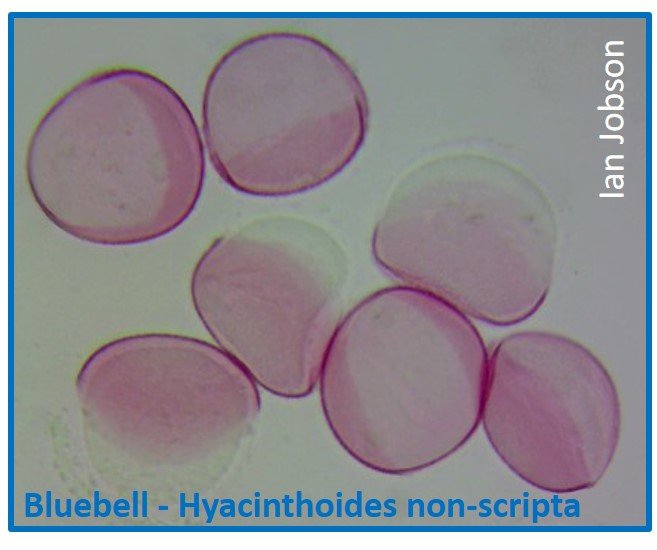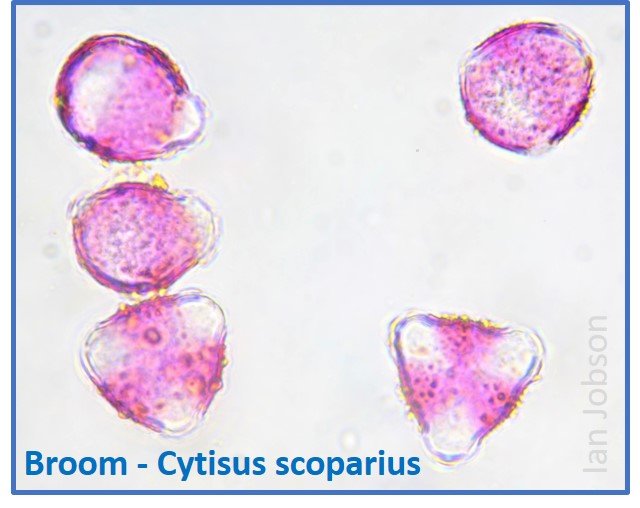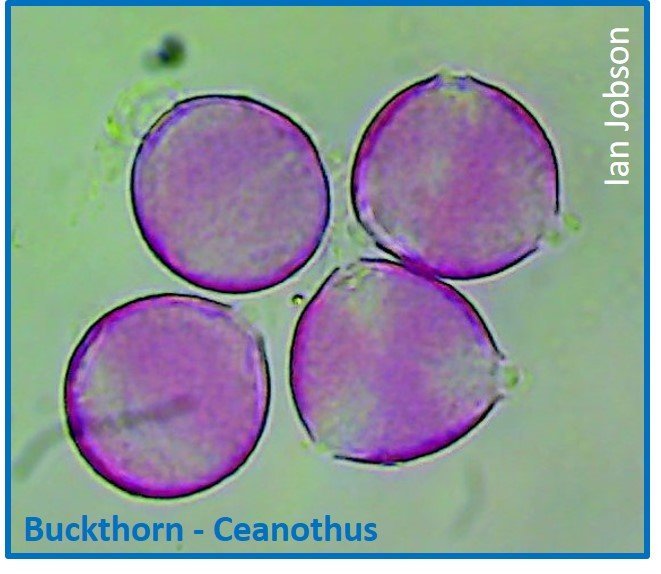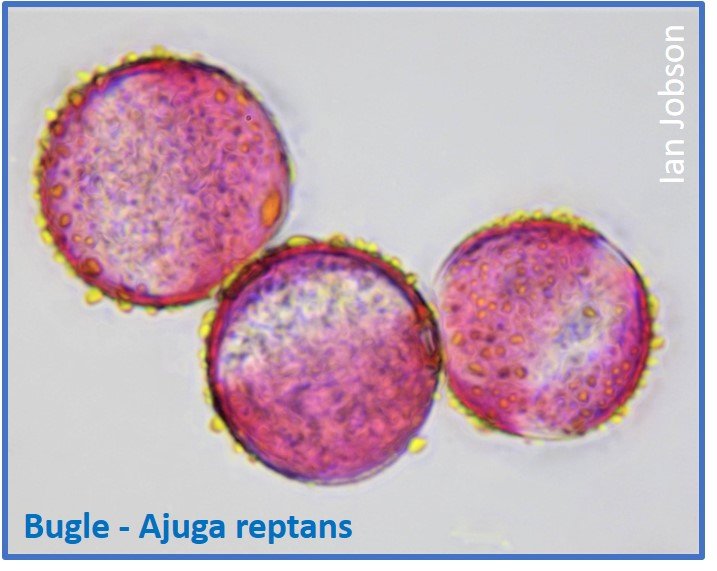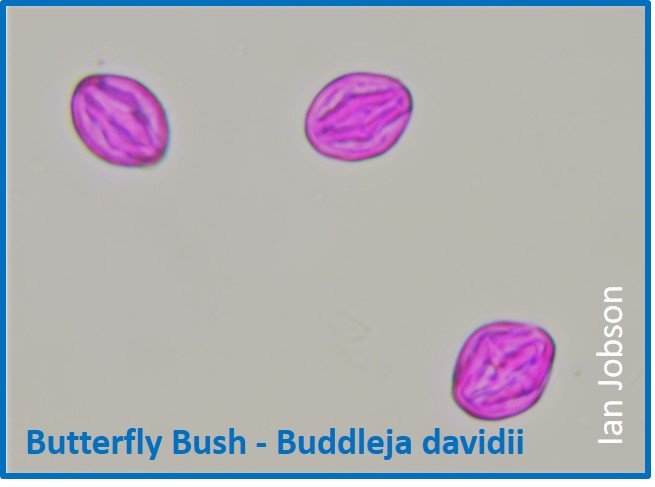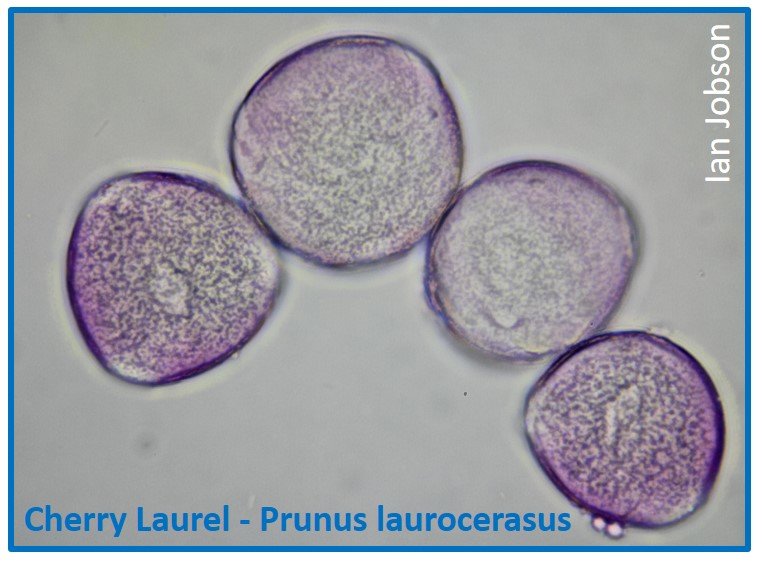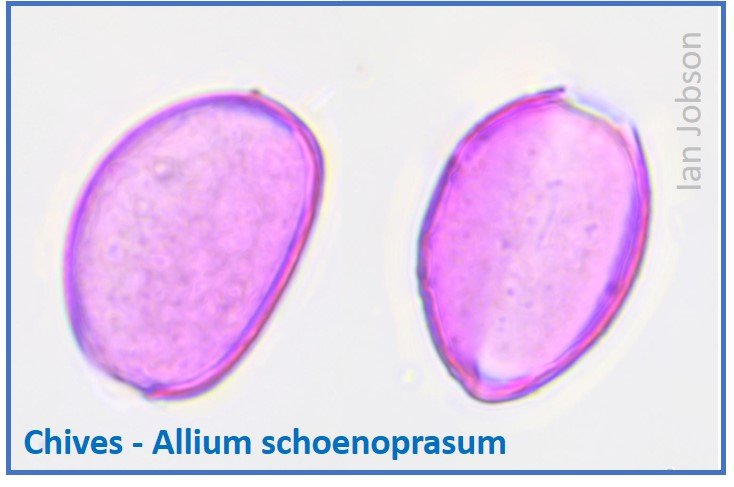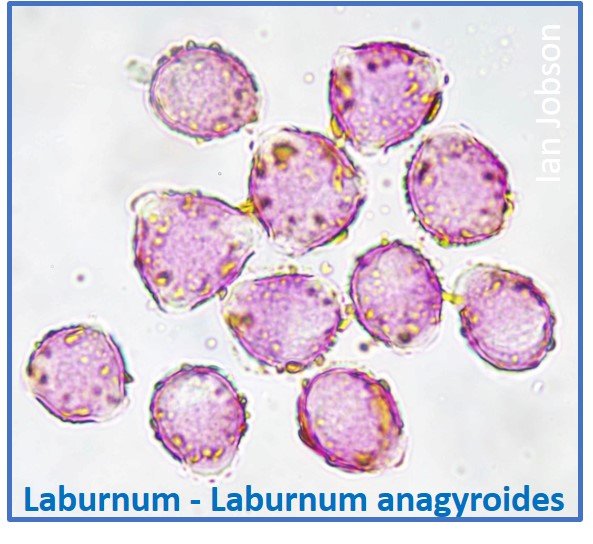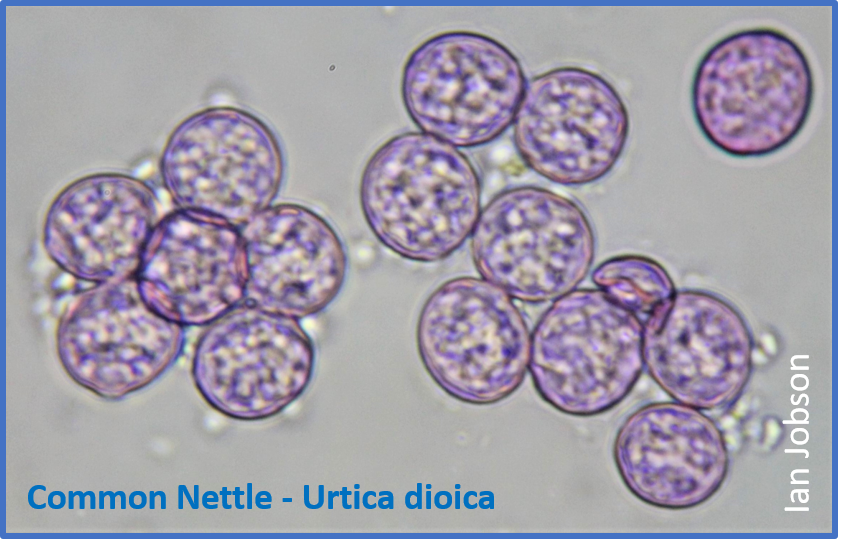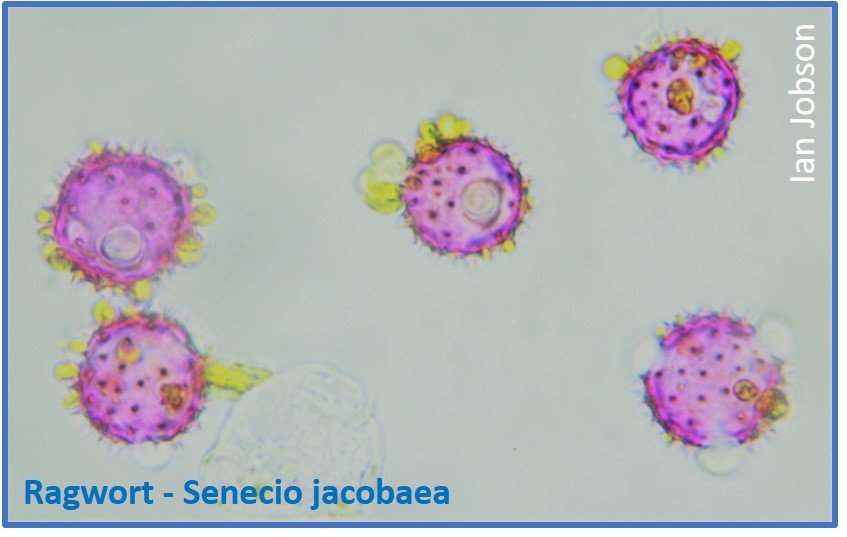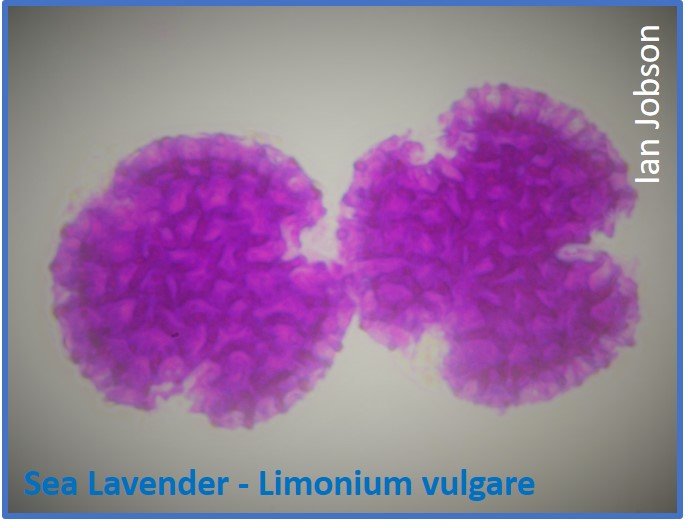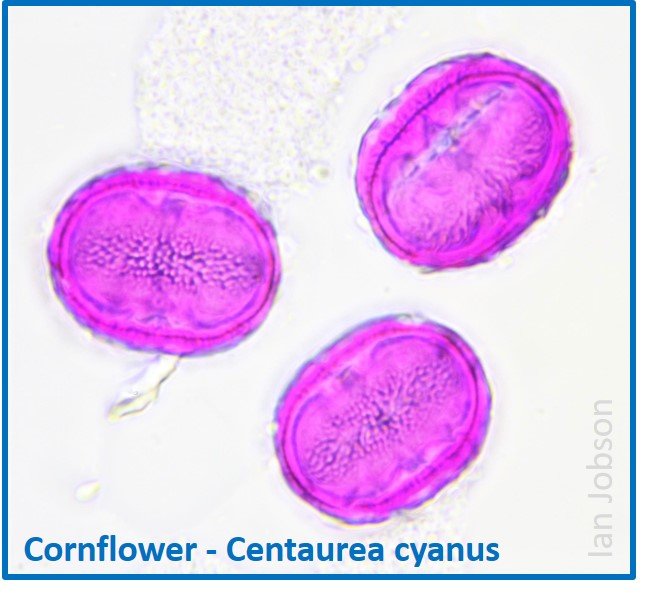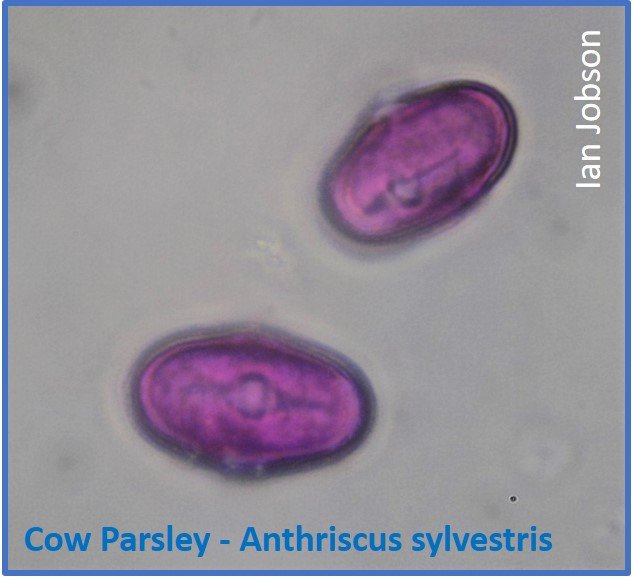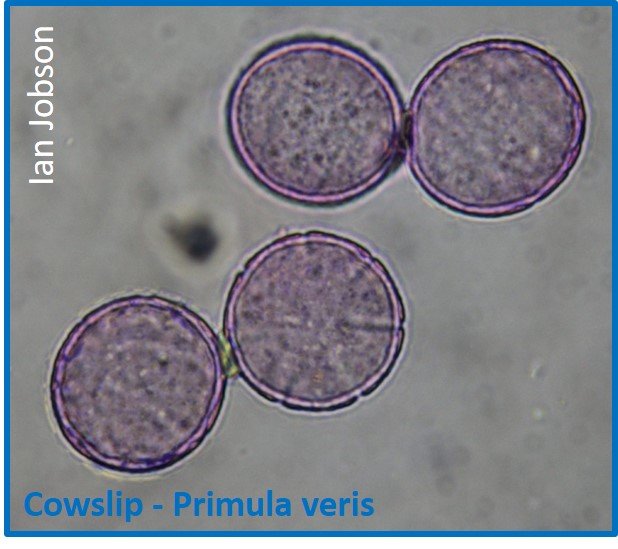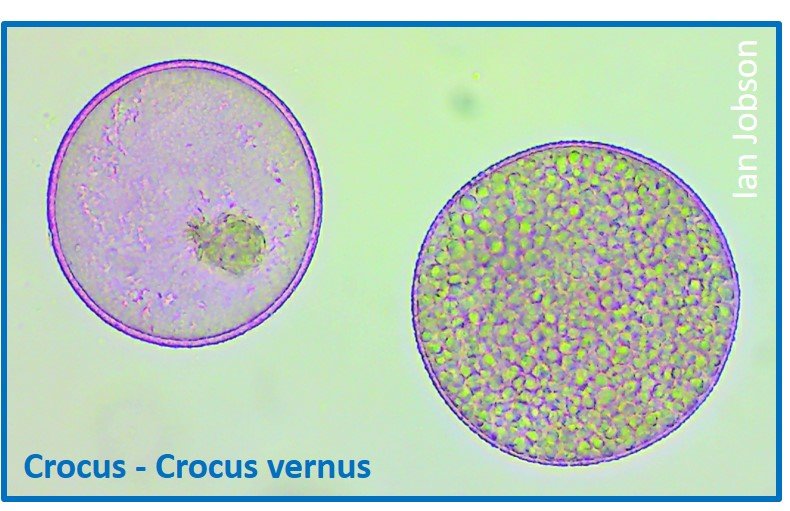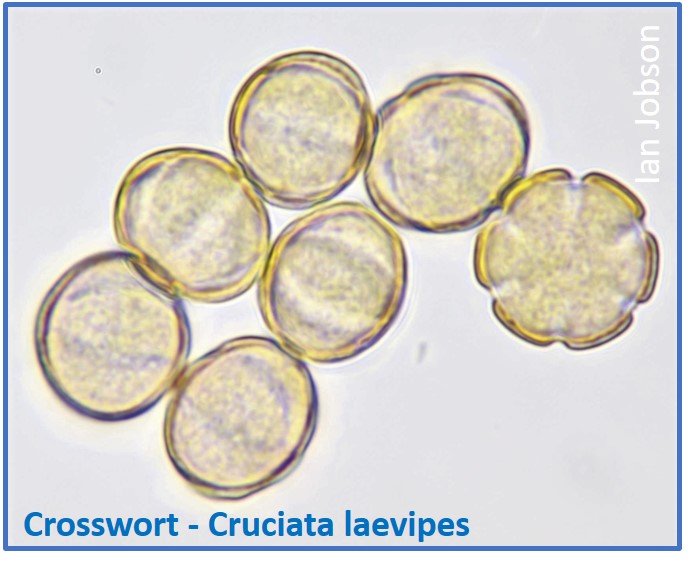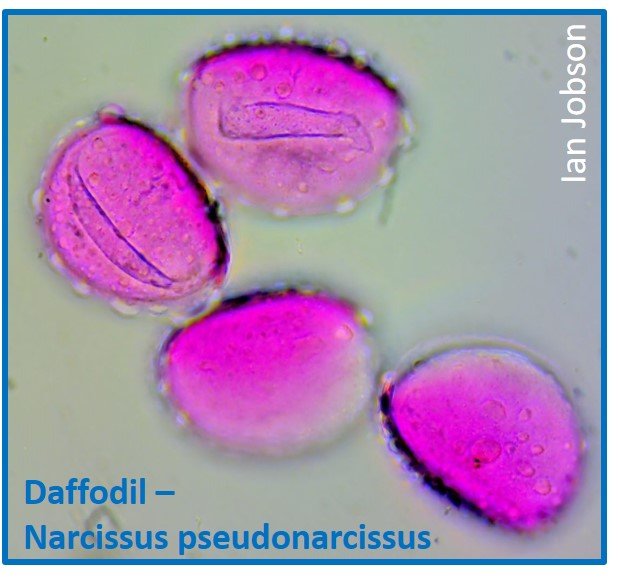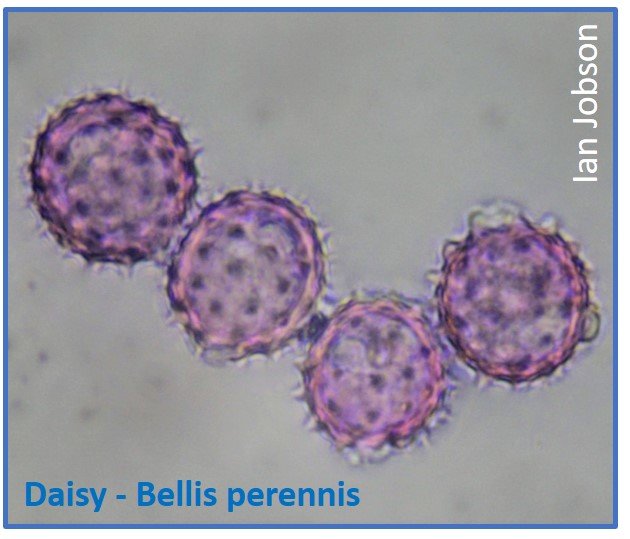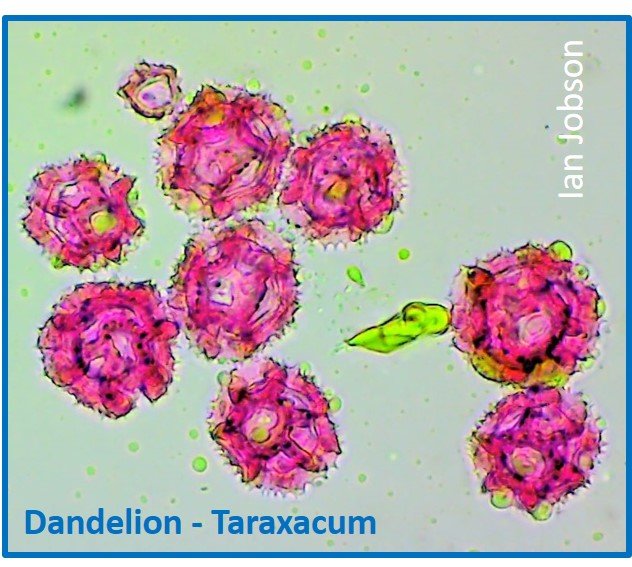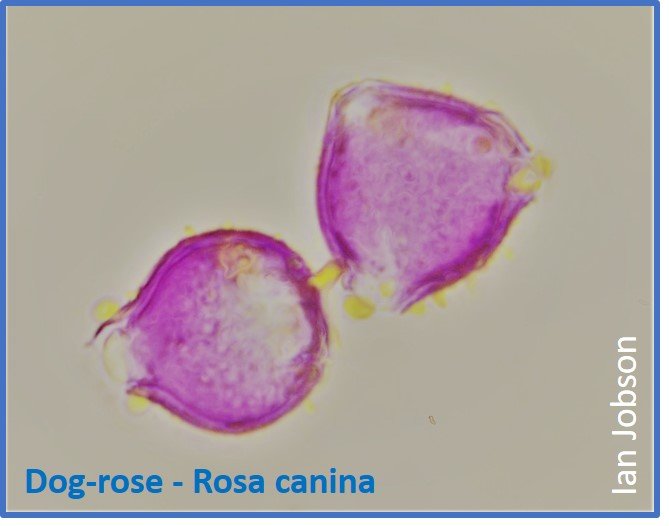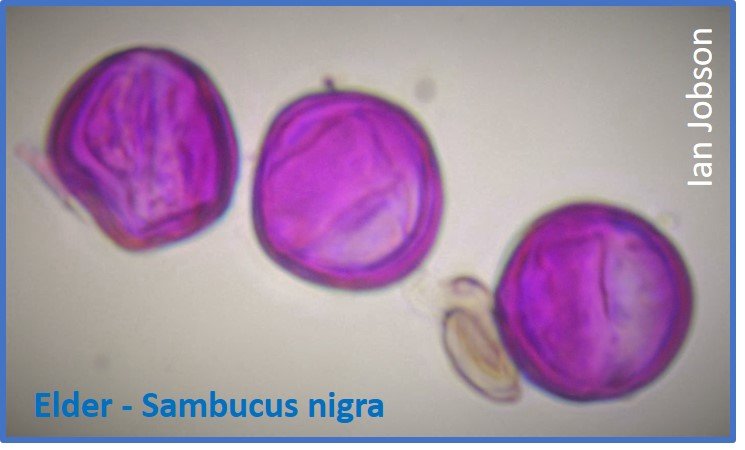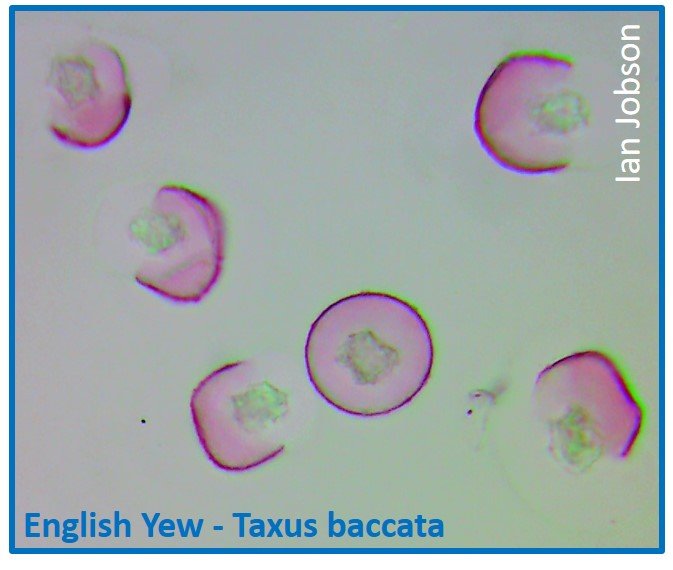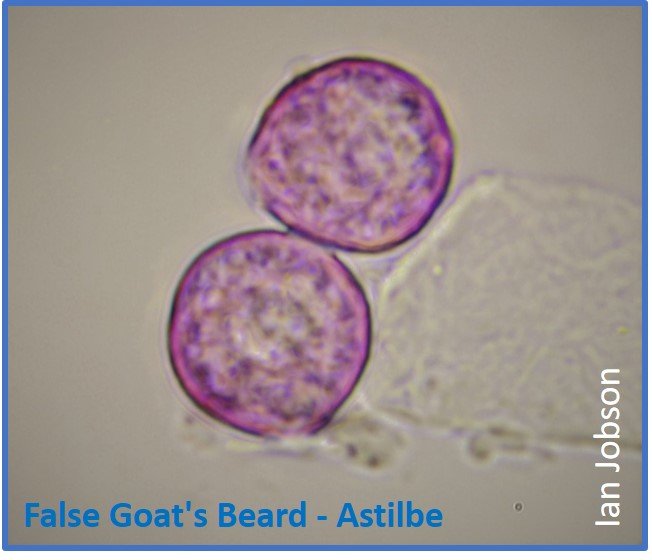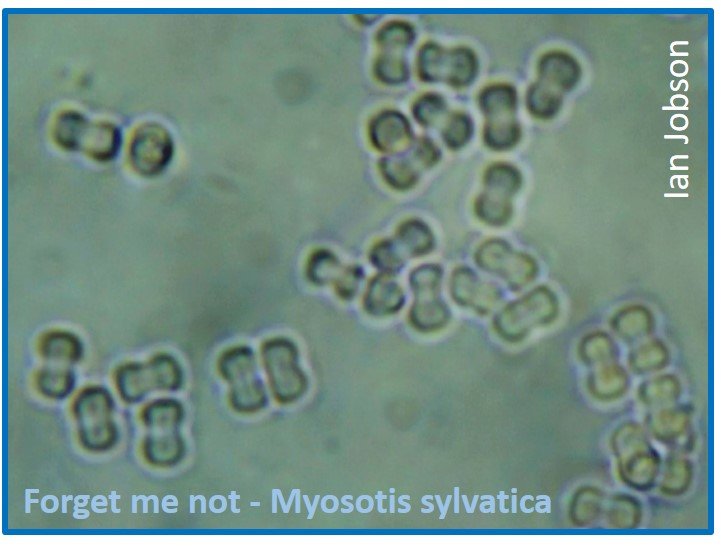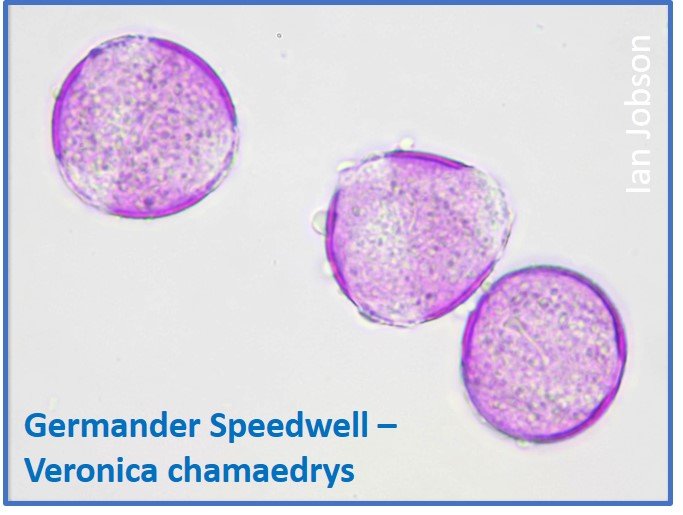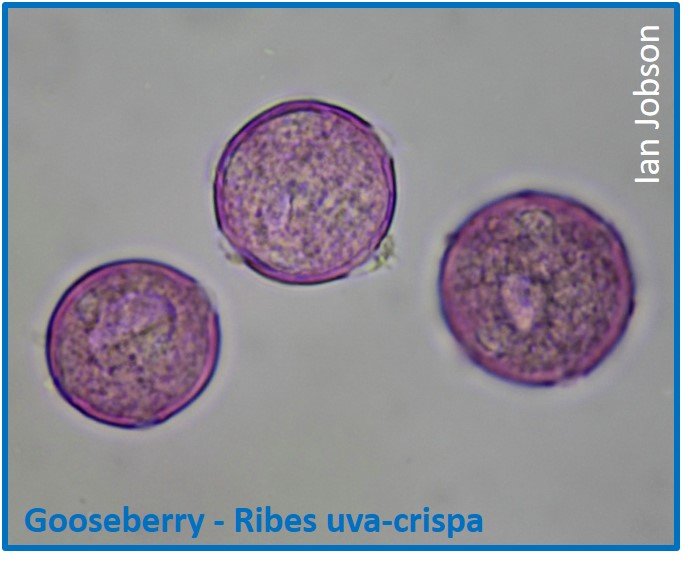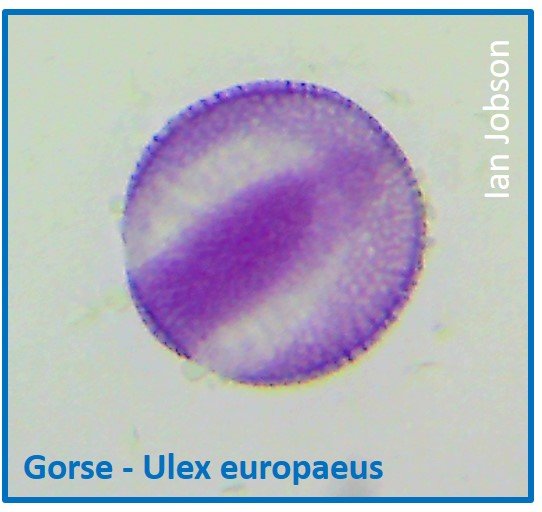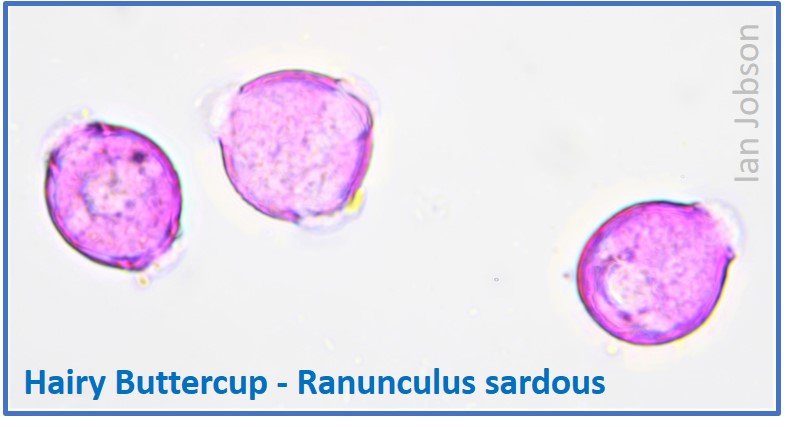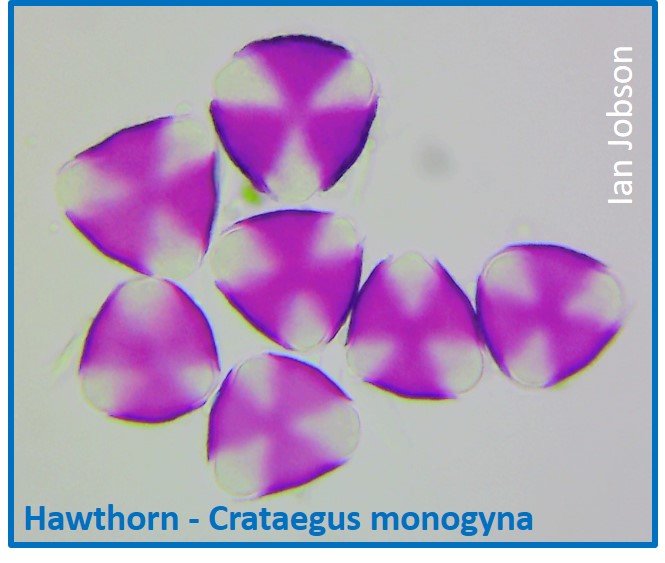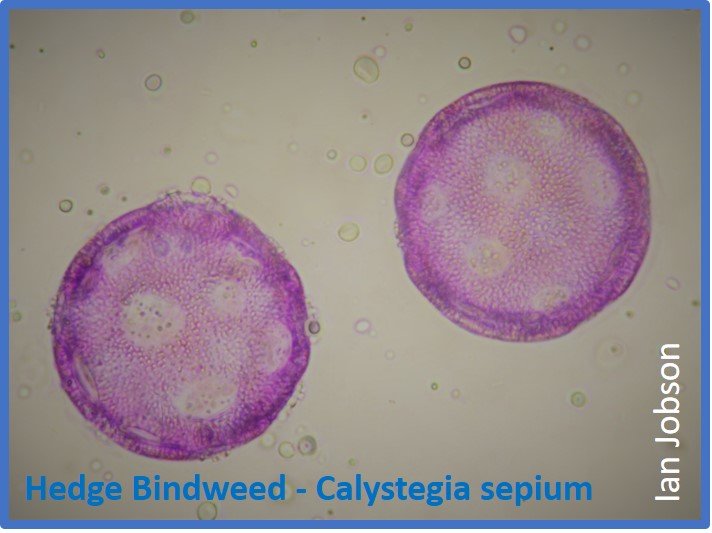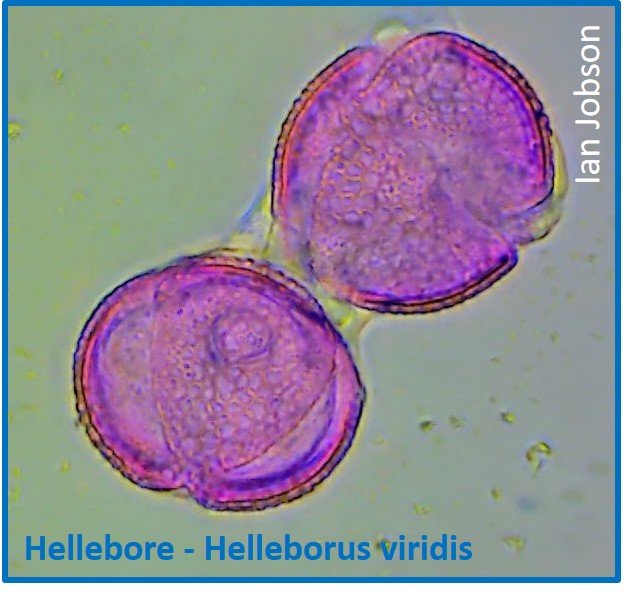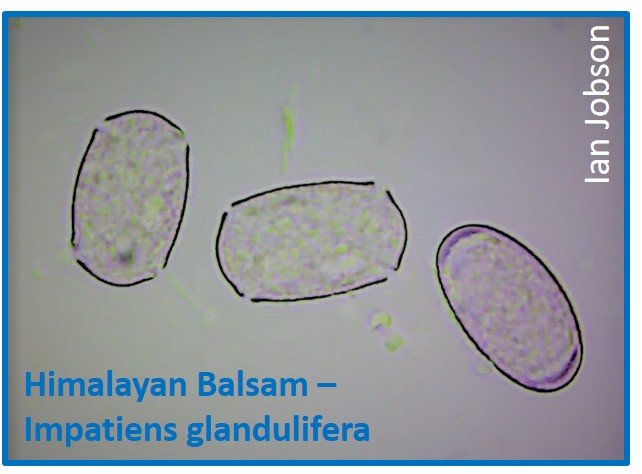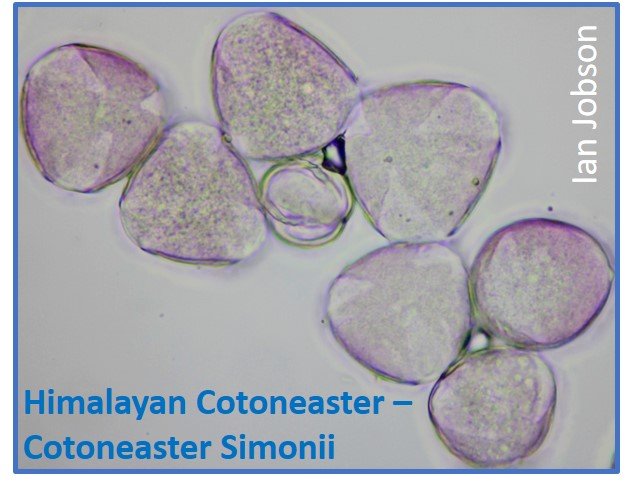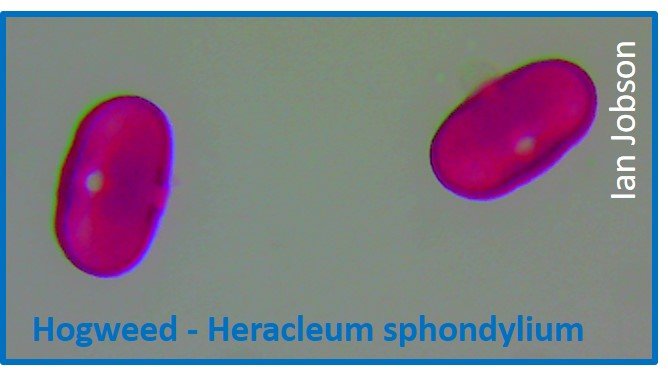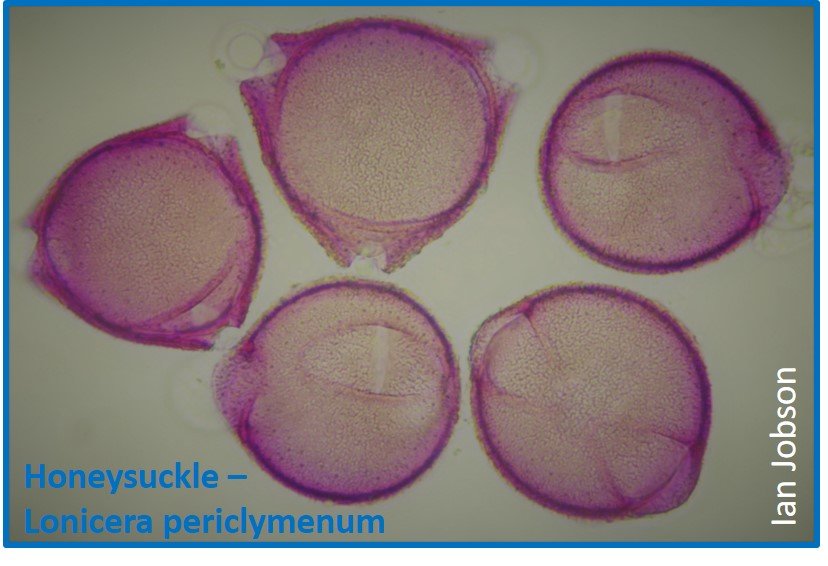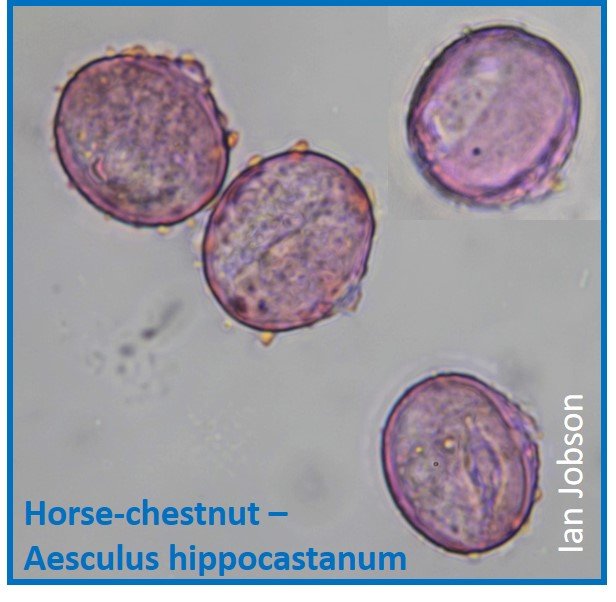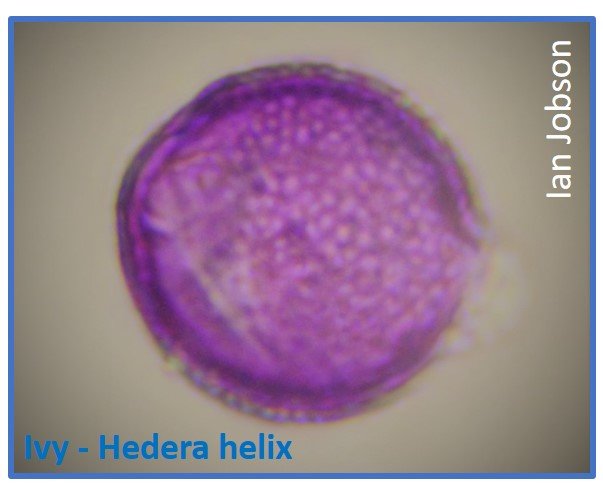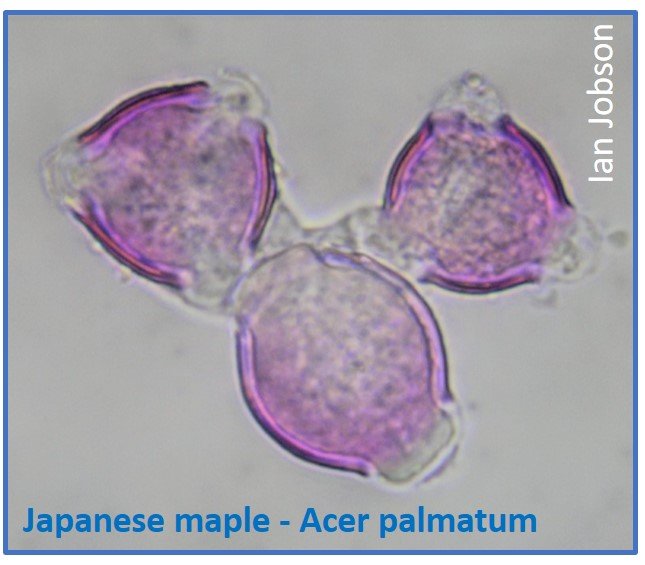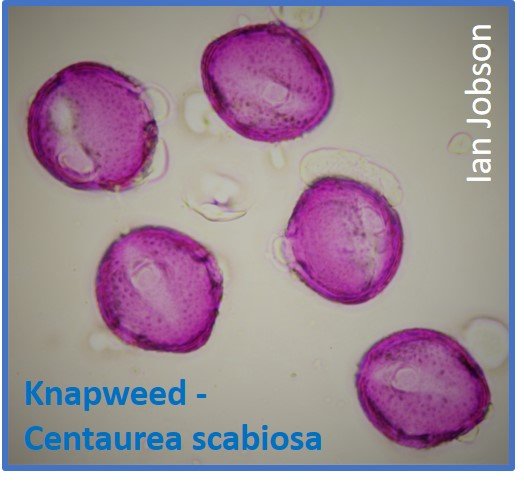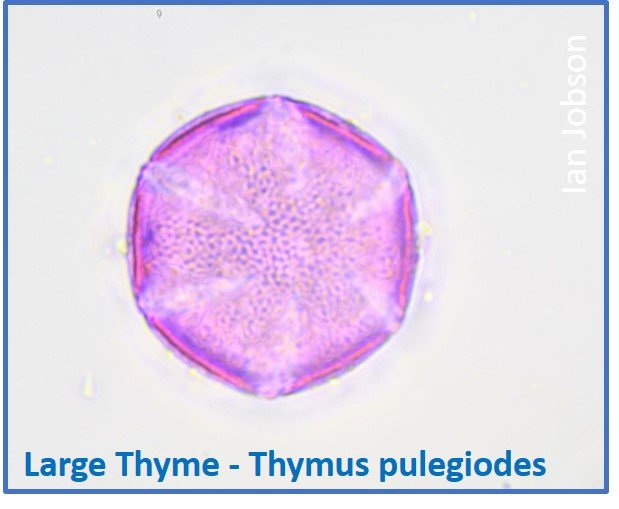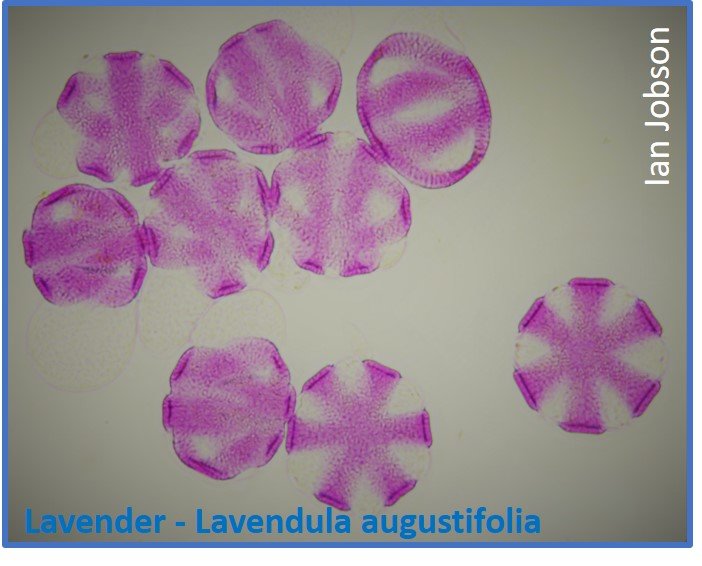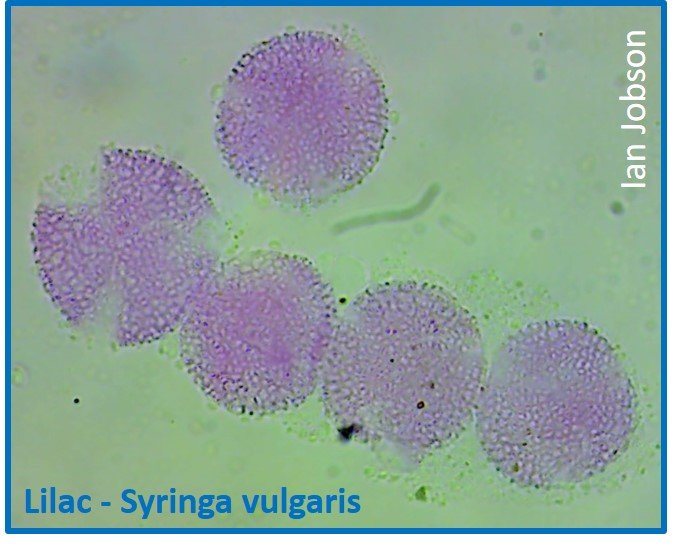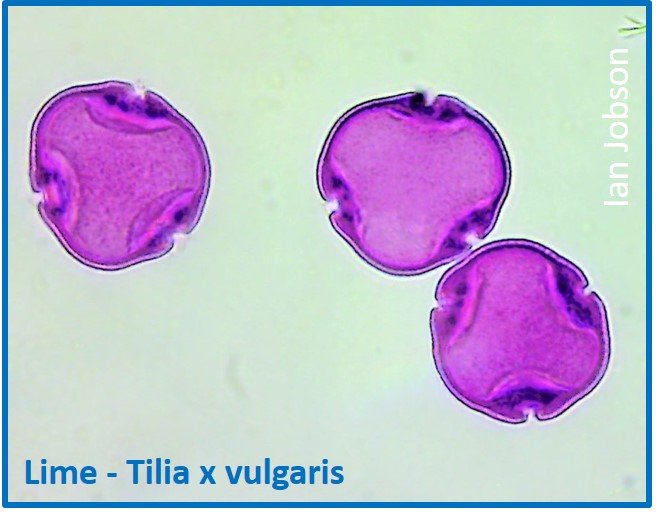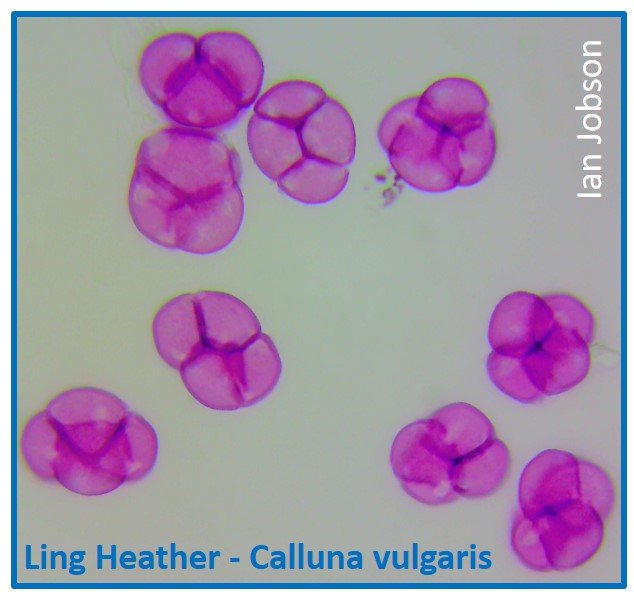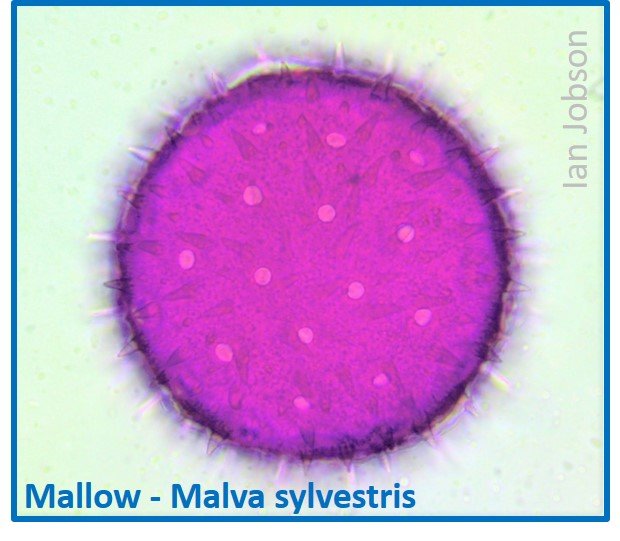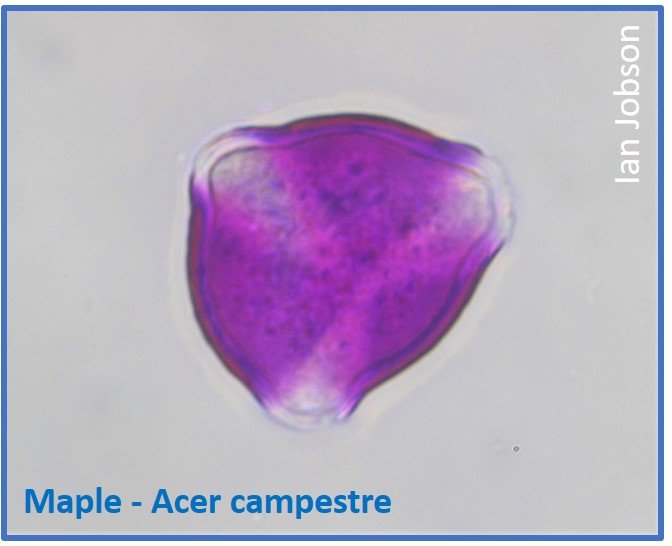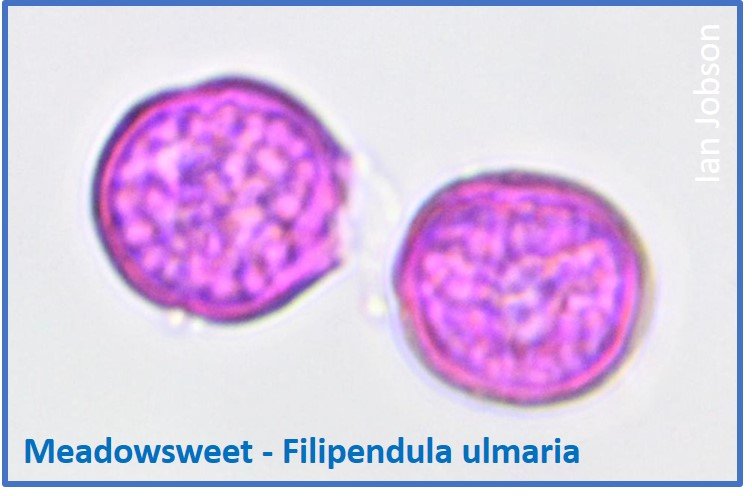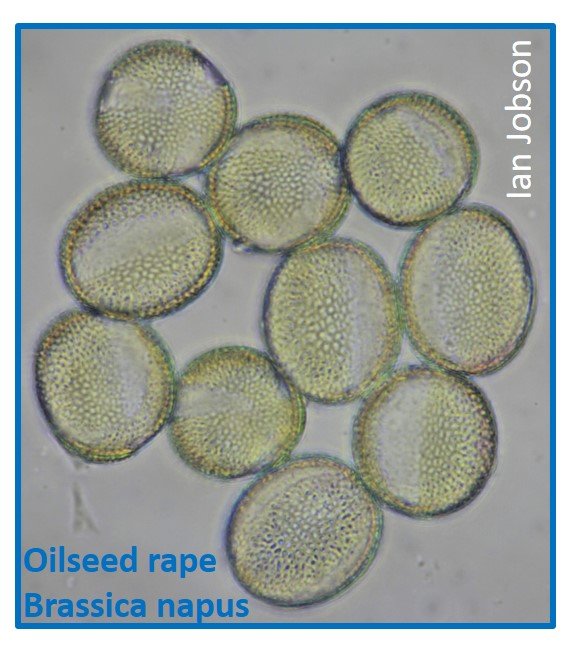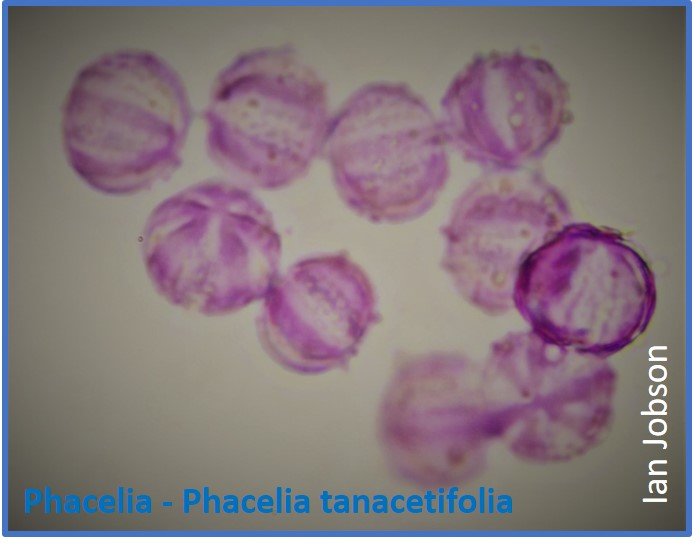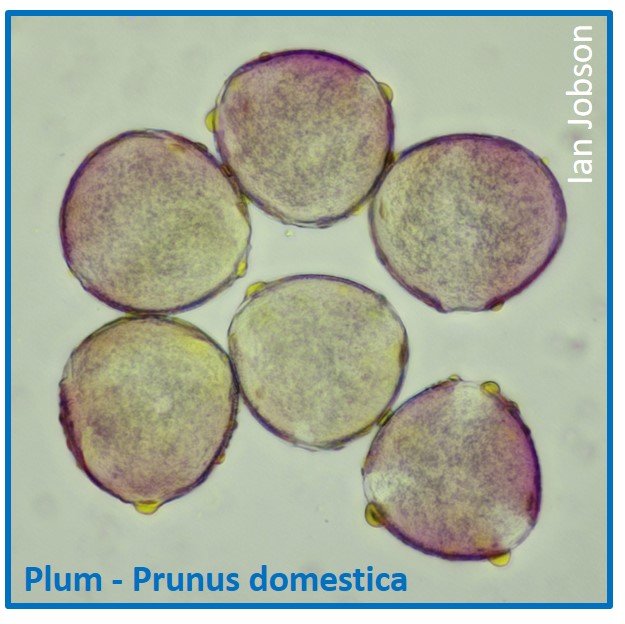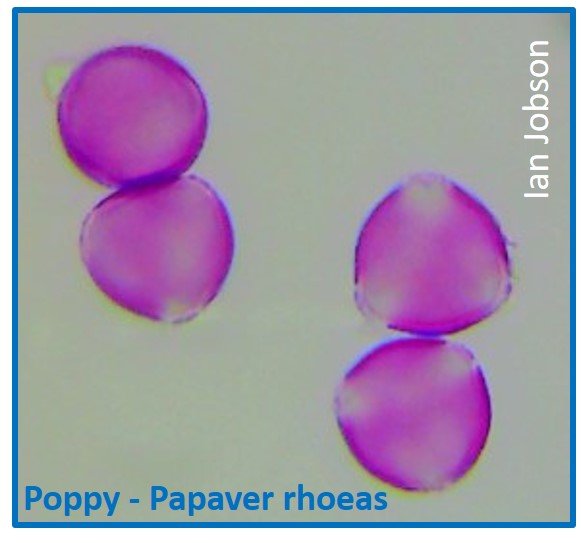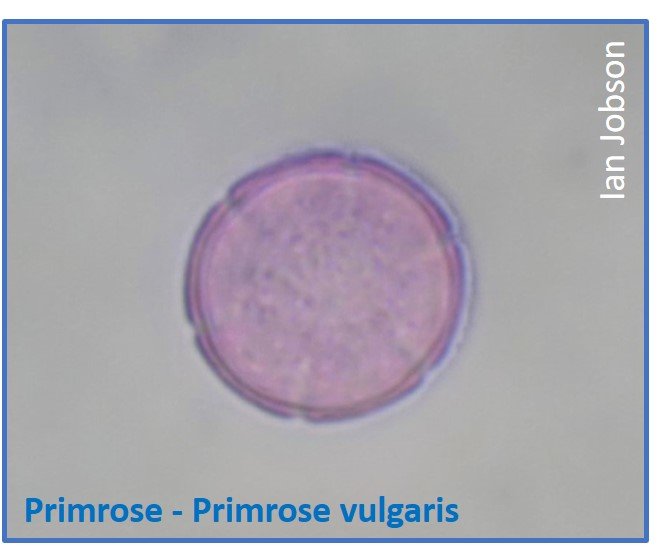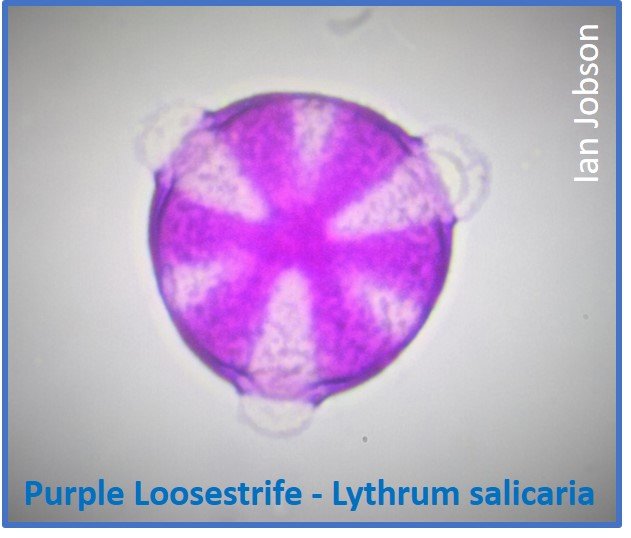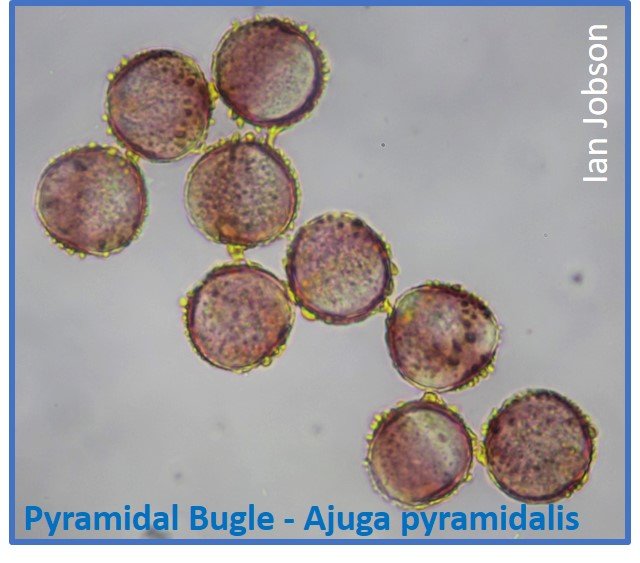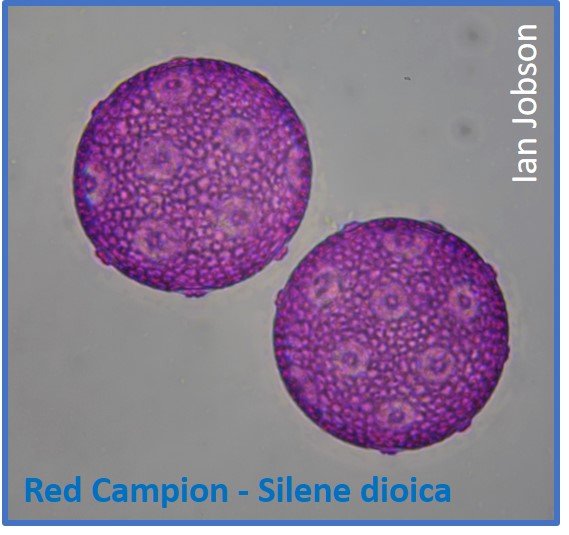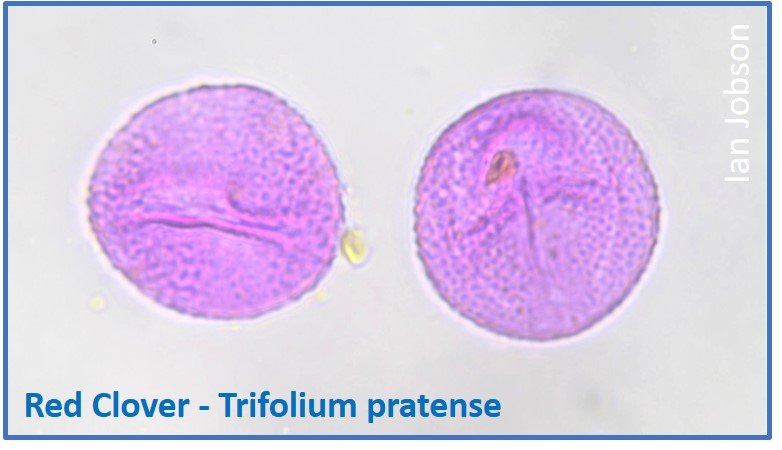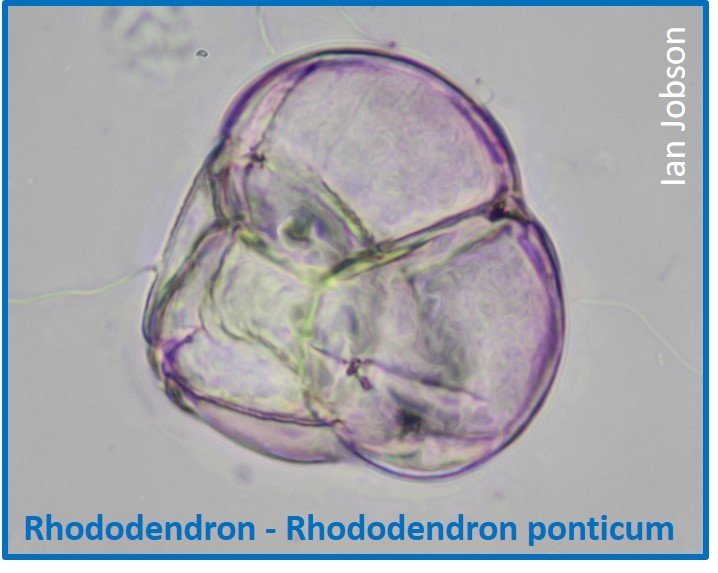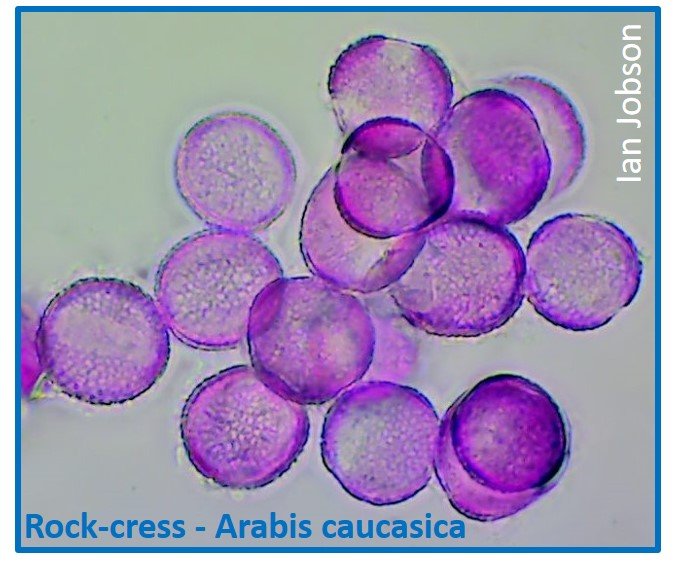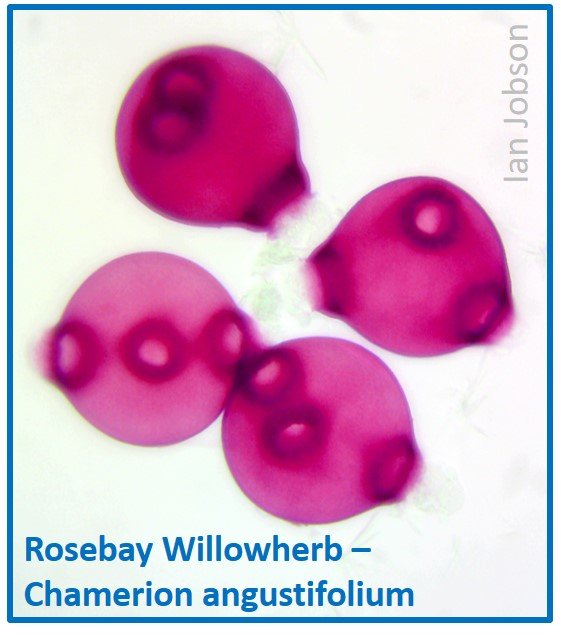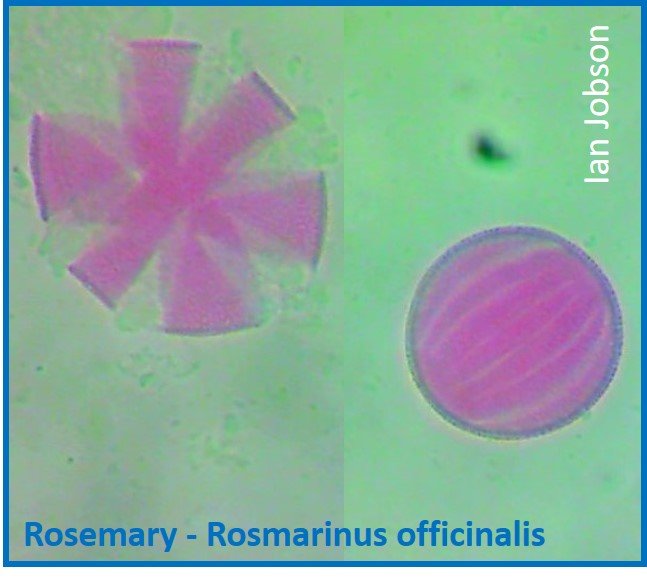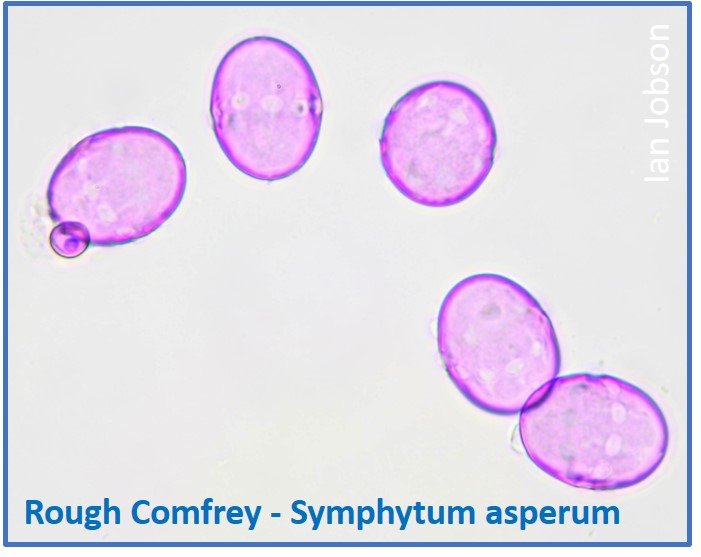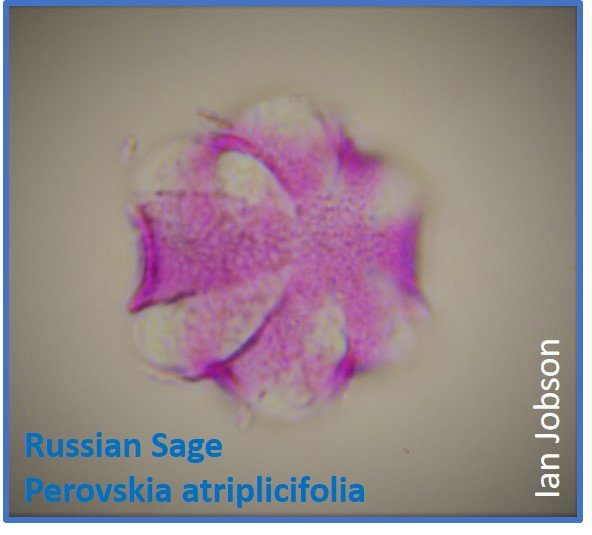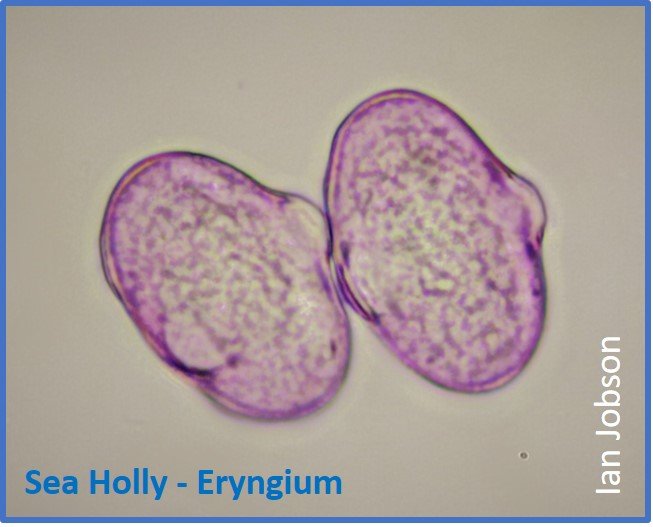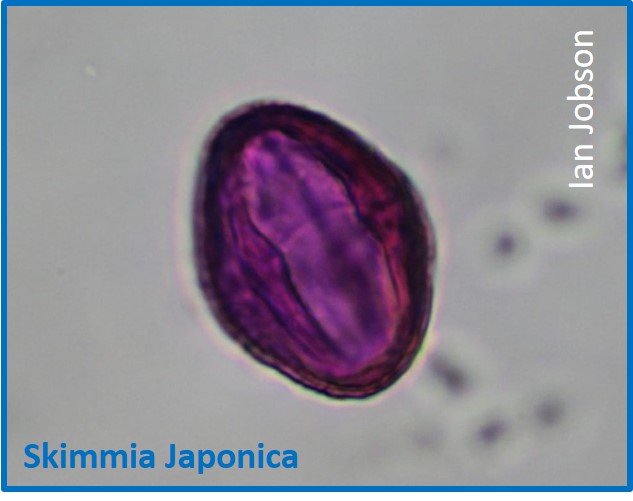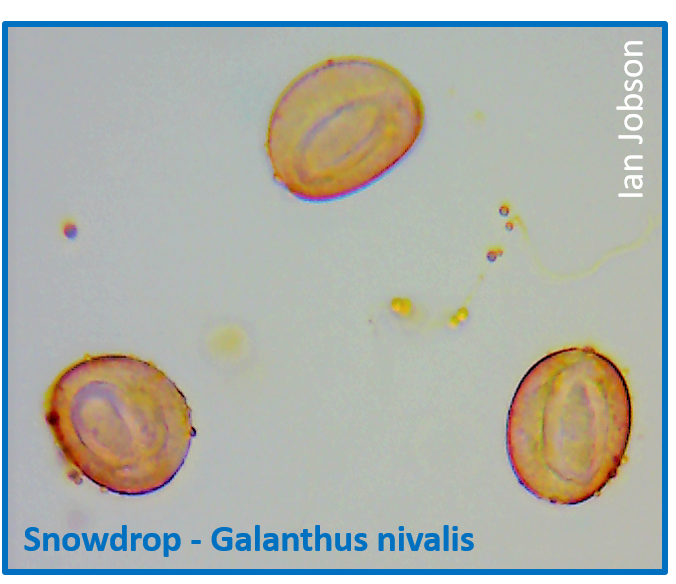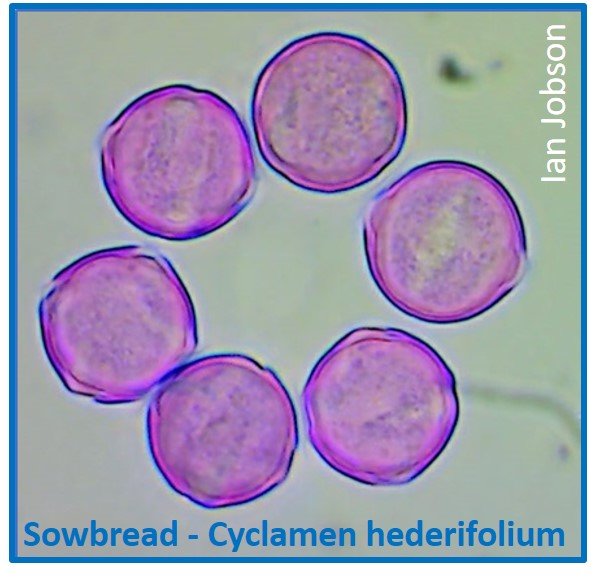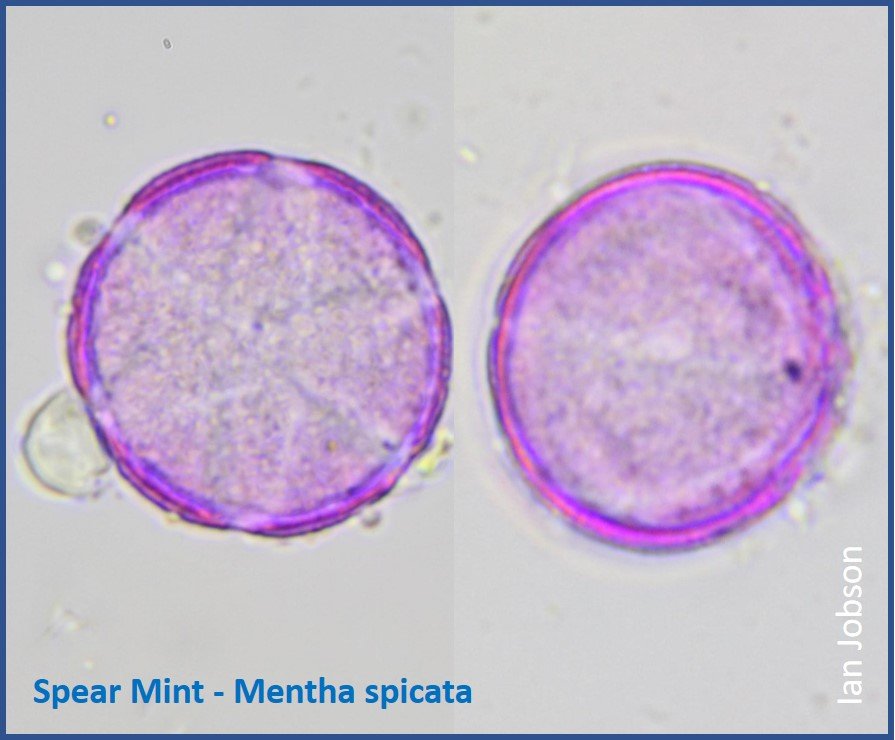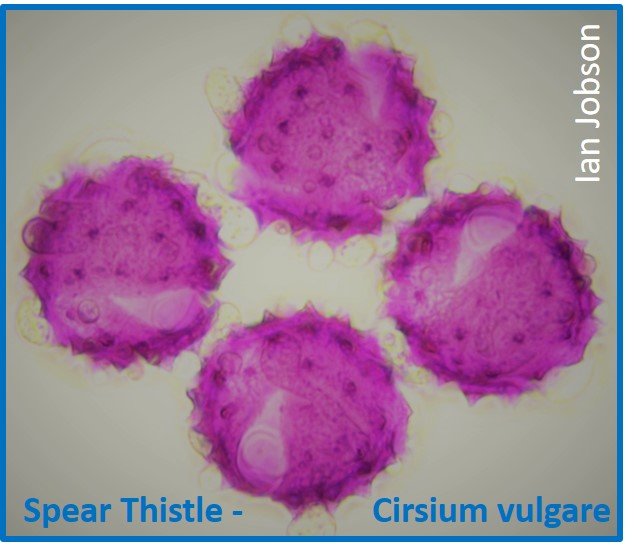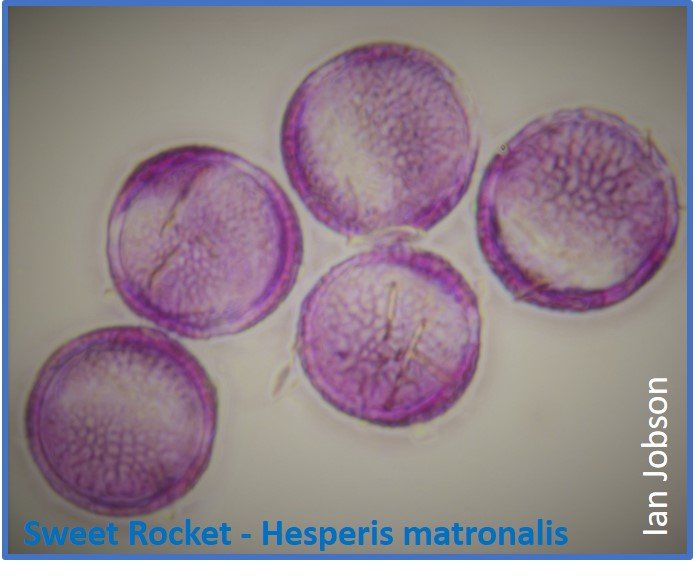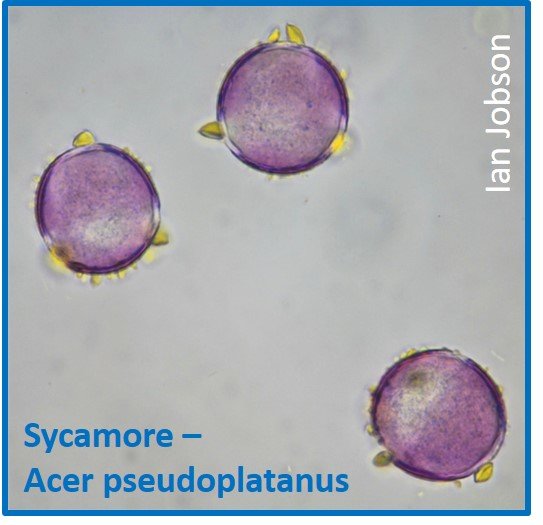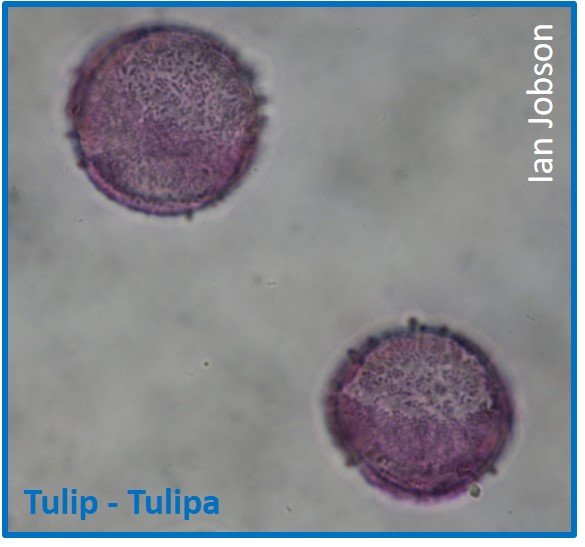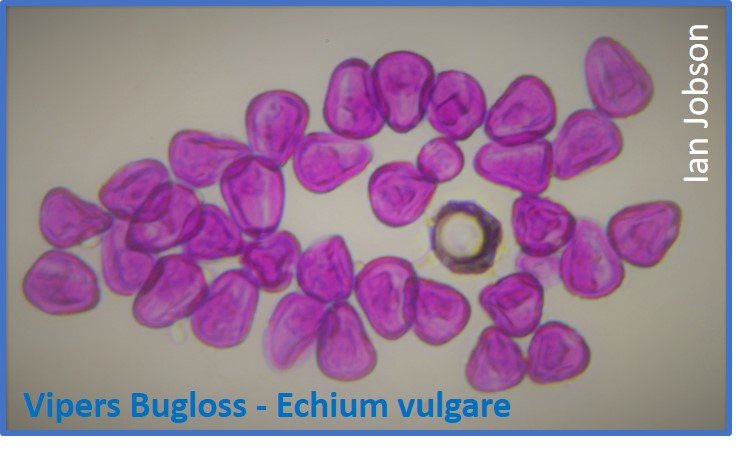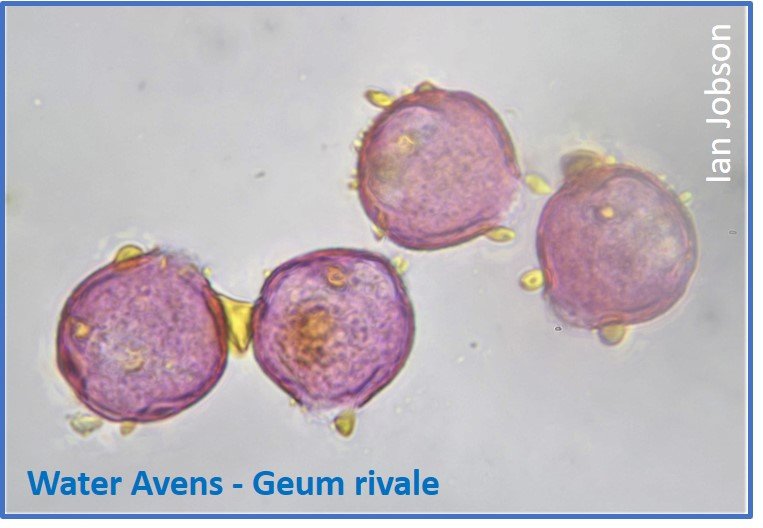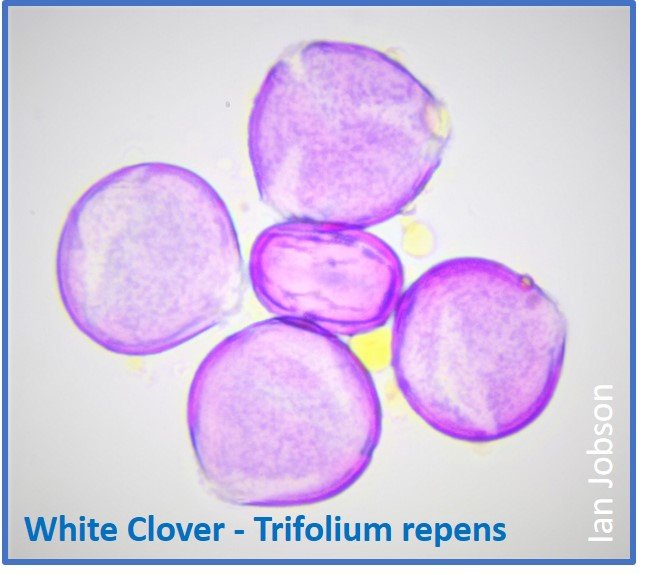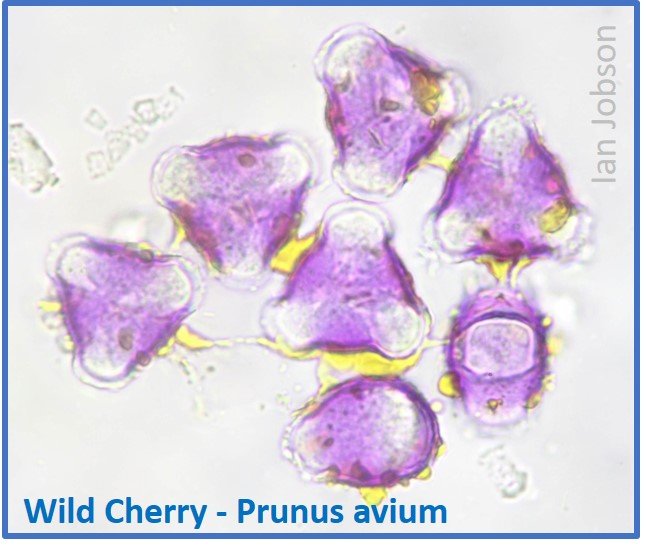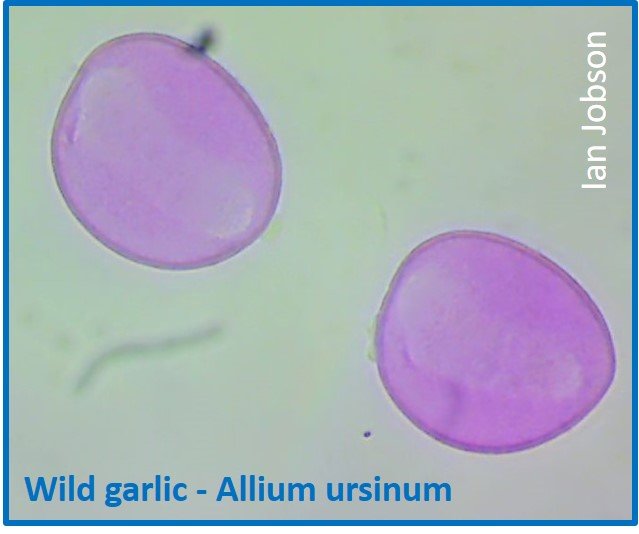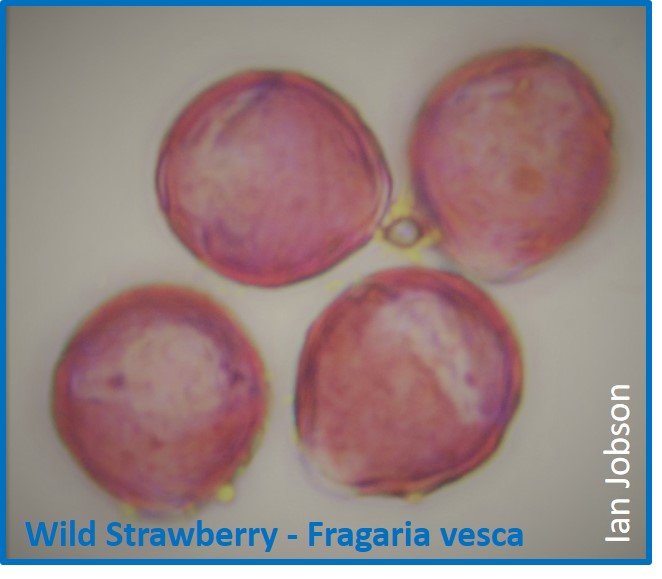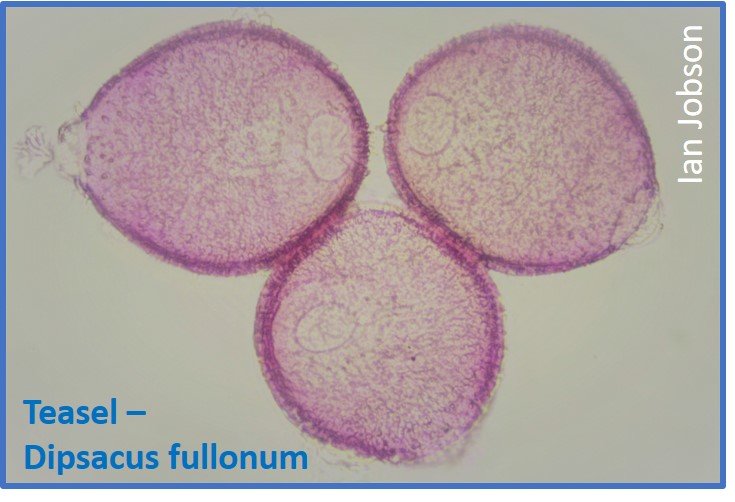Pollen identification gallery
This gallery contains photographs of pollen collected within foraging distance of my honey bee colonies, here in rural Northumberland. The pollen was collected from plants when they were in flower.
The purpose of this gallery is to provide a way of initially identifying a pollen from its overall appearance. For many of the distinctive ones this can be enough but limitation of light microscopes may mean that it is only possible to identify the family.
The pollen gallery photos are in alphabetic order by common name. Try using the filter buttons below to filter by pollen load colour or by one of the top 10 families. See the similarities of pollen within the same family.
AllDicotyledonMonocotyledonGymnospermaeAlliaceaeApiaceaeBoraginaceaeBrassicaceaeEricaceaeFabaceaePrimulaceaeRosaceaeLamiaceaeAsteraceaeYellowBlueBrownGreenWhiteOrangeBlackRed
Apple – Malus pumila Pollen Description : Apple pollen is a rounded triangular shape due to its three swollen furrow
Asparagus – Asparagus officinalis Pollen Description : Asparagus pollen is a round shape and approximately 35 um in diameter. It
Barberry – Berberis vulgaris Pollen Description : Barberry pollen is distinctive due to to roughly rounded shape and its unusual
Bell Heather – Erica cinerea Pollen Description : Bell Heather is distinctive due to its tetrad shape. Its base appears
Bird Cherry – Prunus padus Pollen Description : The body of the pollen is round, although its three short, bulging
Bird’s Foot Trifoil – Lotus corniculatus Pollen Description : Bird’s Foot Trifoil pollen is oval shaped and is approximately 25
Black Current – Ribes nigrum Pollen Description : Black Current pollen is distinctive due to its round shape, its approximately
Blackberry Bramble – Rubus fruticosus Pollen Description : Blackberry Bramble pollen is roughly round in shape, although its three furrow
Blackthorn – Prunus spinosa Pollen Description : This pollen is similar to many of the other members of the Rosaceae family.
Bluebell – Hyacinthoides non-scripta Pollen Description : The pollen grain body is an irregular oval shape and is approximately 70um long,
Broom – Cytisus scoparius Pollen Description : Broom pollen is a triangular shape, due to its three furrow and pore
Buckthorn – Ceanothus Pollen Description : Ceanothus pollen is round in shape and approximately 25 um in diameter. It has
Bugle – Ajuga reptans Pollen Description : Bugle pollen is round in shape and is approximately 30 um in diameter.
Butterfly Bush – Buddleja davidii Pollen Description : Butterfly Bush pollen is rugby-ball shaped and is approximately 20 um in
Cherry Laurel – Prunus laurocerasus Pollen Description : Cherry Laurel pollen is roughly round in shape, although its three furrow
Chives – Allium schoenoprasum Pollen Description : Chive pollen is distinctive due to its oval shape and it’s long, single
Common Laburnum – Laburnum anagyroides Pollen Description : Common Laburnum is roughly round in shape, although it’s three furrow and
Common Nettle – Urtica dioica Pollen Description : Common Nettle pollen is round and approximately 16 um in diameter. It
Common Ragwort – Senecio jacobaea Pollen Description : Common Ragwort pollen is round in shape and approximately 25 um in
Common Sea Lavender – Limonium vulgare Pollen Description : Common Sea Lavender is very distinctive due to its deeply netted
Cornflower – Centaurea cyanus Pollen Description : Cornflower pollen is an oblong shape and 35 um long. It has three
Cow Parsley – Anthriscus sylvestris Pollen Description : Cow Parsley pollen is distinctive due to its elongated oval shape body
Cowslip – Primula veris Pollen Description : Cowslip pollen is round in shape and is approximately 30 um in diameter.
Crocus – Crocus vernus Pollen Description : Crocus pollen is very distinctive due to its large size, its lack of
Crosswort – Cruciata laevipes Pollen Description : Crosswort pollen appears round, when viewed from the poles and oval, when viewed
Daffodil – Narcissus pseudonarcissus Pollen Description : Daffodil pollen is distinctive, due to its boat shape and its single furrow
Daisy – Bellis perennis Pollen Description : Its small size and spikey surface make this pollen quite distinctive. It is
Dandelion – Taraxacum Pollen Description : Dandelion pollen is very distinctive due to jagged and spikey exine structure. It varies
Dog-rose – Rosa canina Pollen Description : Dog-rose pollen is a round, although its three bulging furrow and pore type
Elder – Sambucus nigra Pollen Description : Elder Pollen is roughly round in shape and is approximately 20 um in
English Yew – Taxus baccata Pollen Description : English Yew pollen is round in shape and approximately 30 um in
False Goat’s Beard – Astilbe Pollen Description : False Goat’s Beard pollen is a regular round shape and is approximately
Forget me not – Myosotis sylvatica Pollen Description : Forget me not pollen is very distinctive but can be difficult
Germander Speedwell – Veronica chamaedrys Pollen Description : Germander Speedwell pollen is round, although its three furrow type apertures can
Gooseberry – Ribes uva-crispa Pollen Description : Gooseberry pollen is round in shape and approximately 25 um in diameter. It
Gorse – Ulex europaeus Pollen Description : The pollen grain appears oval when viewed from the equator and becomes more triangular
Hairy Buttercup – Ranunculus sardous Pollen Description : Hairy Buttercup pollen is round and has three furrow and pore type
Hawthorn – Crataegus monogyna Pollen Description : The pollen grain body is round, although its three furrow and pore type apertures
Hedge Bindweed – Calystegia sepium Pollen Description : Hedge Bindweed pollen is distinctive due to its large spherical shape and
Hellebore – Helleborus viridis Pollen Description : Hellebore pollen is roughly round in shape and has three deep and wide
Himalayan Balsam – Impatiens glandulifera Pollen Description : Himalayan Balsam pollen grains are distinctive due to their oval/rectangular shape and
Himalayan Cotoneaster – Cotoneaster Simonii Pollen Description : Himalayan Cotoneaster pollen has a triangular appearance due to its three furrow and
Hogweed – Heracleum sphondylium Pollen Description : Hogweed pollen is distinctive due to its rounded end, cylindrical shape and its three
Honeysuckle – Lonicera periclymenum Pollen Description : Honeysuckle pollen is distinctive due to its furrow and pore apertures, which appear
Horse-chestnut – Aesculus hippocastanum Pollen Description : The Pollen is oval shape and 22um long. It has three furrow and
Ivy – Hedera helix Pollen Description : The Ivy pollen grain body is round and approximately 25um in diameter. It has
Japanese maple – Acer palmatum Pollen Description : Japanese Maple pollen is roughly round but its three bulging furrow and
Knapweed – Centaurea scabiosa Pollen Description : Knapweed pollen is oval shaped and approximately 45 um long. It has three furrow
Large Thyme – Thymus pulegiodes Pollen Description : Large Thyme pollen is round, although its six furrow type apertures give
Lavender – Lavendula augustifolia Pollen Description : Lavender pollen is a squashed ball shape and is approximately 35 um in
Lilac – Syringa vulgaris Pollen Description : Lilac pollen is distinctive due to its round shape, its clearly netted surface
Lime – Tilia x vulgaris Pollen Description : This pollen grain is very distinctive due to the internally undercut shape
Ling Heather – Calluna vulgaris Pollen Description : Ling heather pollen is very distinctive due to its composite tetrad shape, made
Mallow – Malva sylvestris Pollen Description : Mallow has one of the larger pollen grains and is very distinctive. It
Maple – Acer campestre Pollen Description : Maple pollen is oval when view from the equator but its three furrow
Meadow Crane’s-bill – Geranium pratense Pollen Description : Meadow Crane’s-bill pollen is distinctive due to its large round shape, its
Meadowsweet – Filipendula ulmaria Pollen Description : Meadowsweet pollen is round and approximately 15 um in diameter. It has three
Oilseed rape – Brassica napus Pollen Description : Oilseed rape pollen is oval in shape and approximately 25 um long.
Phacelia – Phacelia tanacetifolia Pollen Description : When viewed from the poles, Phacelia pollen is a round shape. Although, when viewed
Plum – Prunus domestica Pollen Description : Plum pollen is round in shape, although its three furrow type pores give
Poppy – Papaver rhoeas Pollen Description : The Poppy pollen grain is round, although its three furrow and pore apertures give
Primrose – Primrose vulgaris Pollen Description : The Primrose pollen is spherical and approximately 30 um in diameter. It has
Purple Loosestrife – Lythrum salicaria Pollen Description : The distinctive Purple Loosestrife pollen is round in shape and approximately 28 um
Pyramidal Bugle – Ajuga pyramidalis Pollen Description : Pyramidal Bugle pollen is roughly round in shape, although its three furrow
Red Campion – Silene dioica Pollen Description : Red Campion pollen is very distinctive due it’s regular, round shape, its
Red Clover – Trifolium pratense Pollen Description : Red Clover pollen is roughly round in shape and approximately 40 um
Rhododendron – Rhododendron ponticum Pollen Description : Rhododendron pollen is distinctive due to its composite structure of three fused bodies,
Rock-cress – Arabis caucasica Pollen Description : Rock-cress pollen is round in shape and has three furrow type apertures. It
Rosebay Willowherb – chamerion angustifolium Pollen : Rosebay Willowbay pollen is large and has a distinctive shape. It is approximately
Rosemary – Rosmarinus officinalis Pollen Description : The pollen grain is round in shape and similar to others of the
Rough Comfrey – Symphytum asperum Pollen Description : Rough Comfrey pollen is distinctive due to its regular oval shape, its
Russian Sage – Perovskia atriplicifolia Pollen : Russian Sage pollen is a bulging star shape, due to its six, large,
Sea Holly – Eryngium Pollen Description : Sea Holly pollen is an oval shape and approximately 40um long. It has
Skimmia Japonica Pollen Description : Skimmia Japonica pollen is rugby ball shaped and approximately 40 um long. The exine section
Snowdrop – Galanthus nivalis Pollen Description : Snowdrop pollen is an oval shape and approximately 25 um long. It has one
Sowbread – Cyclamen hederifolium Pollen Description : Sowbread pollen is a regular round shape and has four furrow and pore
Spear Mint – Mentha spicata Pollen Description : Spear Mint is uniformly round in shape and approximately 30 um in
Spear Thistle – Cirsium vulgare Pollen Description : Spear Thistle pollen is distinctive due to its round jagged shape and
Sweet Rocket – Hesperis matronalis Pollen Description : Sweet Rocket pollen is round and approximately 32 um in diameter. It
Sycamore – Acer pseudoplatanus Pollen Description : Sycamore pollen is round in shape, although its three furrow and pore apertures
Tulip – Tulipa Pollen Description : Tulip pollen is round in shape and approximately 60 um in diameter. It appears
Vipers Bugloss – Echium vulgare Pollen Description : Vipers Bugloss pollen is distinctive due to its tiny, conical, triangular shape.
Water Avens – Geum rivale Pollen Description : Water Avens pollen is roughly round but is distorted by its three
White Clover – Trifolium repens Pollen Description : White clover pollen is a round shape, although its three furrow type
Wild Cherry – Prunus avium Pollen Description : The body of Wild Cherry pollen is round but its three large pore
Wild garlic – Allium ursinum Pollen Description : Wild Garlic pollen is characteristic of the Allium Family. It is a
Wild Strawberry – Fragaria vesca Pollen Description : Wild Strawberry pollen is round and 18 um in diameter, although its
Wild Teasel – Dipsacus fullonum Pollen Description : Wild Teasel pollen is oval in shape and is approximately 105 um
Also see our Plants for Bees Gallery.
If you have found this page useful, please like and share on facebook. If you would like to receive new posts in future, please enter your email in the Subscribe box on the home page.
Acknowledgements
- Rex Sawyer’s book, Pollen Identification for beekeepers is essential reading for understanding the features of pollen. He defines much of the vocabulary to explain pollen features, as well as establishing the acknowledged Pollen Identification Key.
- Bob Maurer’s book, Practical Microscopy for Beekeepers, was helpful in starting in microscopy and shows some simple techniques for making up pollen slides.
- The NDB Microscopy short course and NDB Advanced courses provided excellent training on microscopy skills.
- The PalDat – Palynological Database was a great reference for looking at SEM photographs of pollen grain features, when my light microscope reached its limits.
- Brunel Microscopes after sales service was very helpful in setting up the microscope, camera and computer configuration.
- Zerene Stacker’s excellent layering software was used to improve the clarity and depth of focus on some of the images.


